The Reader of the 11th edition of Alternative Education Programme
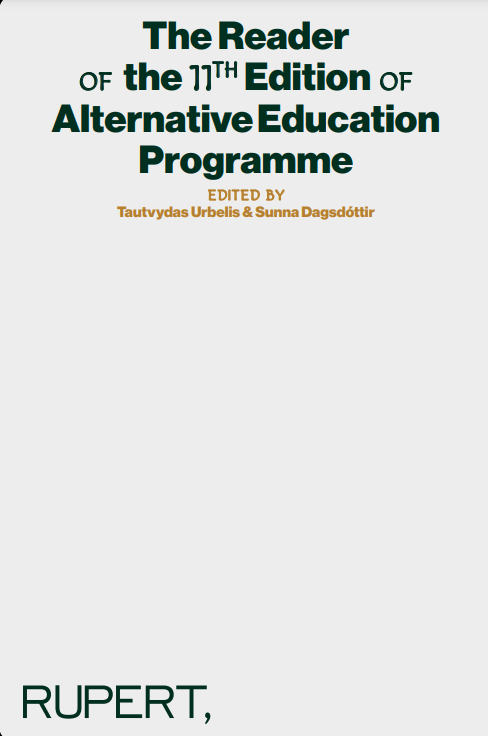
Introduction
“The Reader of the 11th Edition of the Alternative Education Programme” is an open-source documentation of AEP’s activities, outcomes of the participants’ projects and programme’s bibliography. The reader is aimed to provide a coinciding but comprehensive introduction to AEP’s commitment to alternative learning, professional development and research.
Rupert’s Alternative Education Programme (AEP) is a para-academic study programme embracing decentralised knowledge exchange, intersectionality and process-oriented research and development (R&D). It seeks to expand the academic field by promoting self-study practices, peer learning and close relationships between participants and tutors.
Each year, up to 10 participants are selected to take part in the programme, which provides them with the opportunity to develop their projects through a series of workshops, lectures, seminars, research trips and studio visits. The six-month programme culminates in a final show and publication. The curriculum is part-time and compatible with other commitments. During their stay in Vilnius, participants are introduced to the local art scene, invited to take part in Rupert’s other activities and engage with the residents of the institution.
Although the Alternative Education Programme is based on an already-developed methodological framework, the participants are encouraged to propose additional activities and engage in self-organised practices, for which Rupert is willing to provide curatorial and material support.
Participants
allsofeatherlightseven (duo of Gabija Pernavaitė and Žygimantas Bėrontas)
Thinner, sparrow.
The silhouette is smooth, light, although it remains framed, black.
Take a look above.
Gifts of the Water Depths. this landscape can become confused, sad
and urgent. And then this double winged butterfly-like creature. My
memories are duplicated by spells of uncertainty.
We are falling slowly.
Working with a wide variety of media and techniques, Églantine Laprie-Sentenac has constructed several series of sculptures, structures and volumes that house collected objects. More recently working with wrapping paper, postcards and gift ribbons, Églantine plays with the idea of containers that aren’t holding anything. The notion of gift is put into question: what does it mean to (not) give something, and inversely, what does it mean to (not) receive from someone? Through the manipulation of images, material and found items, her work is infused with remembrances that feel new. While enveloping and de-enveloping objects on their own, an interesting game of hide-and-seek is manifested that questions notions of intimacy and affectivity. Her sculptures are habitats for things we don’t know yet. Églantine Laprie-Sentenac holds an MA in Fine Arts from ENSBA Lyon (2021). The text was written by Henriette Gillerot.
Eglė Ruibytė is a visual artist and graphic designer who, while combining these two disciplines, is longing for meaning in particularly standardised global processes. She graduated in Graphic Art from Vilnius Academy of Arts and in Typography, which eventually turned into Sculpture, from Hamburg University of Fine Arts (HFBK Hamburg). Delving into the technologies of industrial labour and searching for functional metaphors, she constructs mass-produced-looking objects partly by means of manual work. In this way, she deliberately leaves space for errors that speak of humanness within the limits of an industrial machine.
Ella Jo Skinner is a Welsh visual artist creating visceral, sensational experiences. Her provocative and bodily installations merge different disciplines to achieve an art form that engages all six senses and provokes primal reactions within her audiences. She is interested in using art as a transformative experience to explore uncomfortable issues within the contemporary age.
While studying for a bachelor’s degree in English Literature and History of Art at The University of Manchester (2016-2019), she began operating within DIY experimental scenes in the UK. Her immersion in the gritty world of harsh noise and the electronic rave scene led her to begin creating environments that challenged traditional conceptions of art, discipline and order.
Ella graduated with a Master in Fine Art in 2021 from Manchester School of Art. As well as exhibiting her work across the UK and Europe, her work is used within the music industry, her previous clients include Philip Glass and Valgeir Sigurðsson.
Kamilė Krasauskaitė is a multidisciplinary artist and curator based in Vilnius. Her practice evolves into different formats, from installations and sculptures to graphic art, publications and social events. Kamilė is interested in preserving ancient crafts as a deep code to unlock connections with various levels of our everyday life, including indigenous cultures’ beliefs and practices. She is interested in place and space, exploring how certain spaces can supposedly bring physical, mystical and moral transformations to individuals, both human and non-human.
Lux Sauer is an Utrecht-based dance maker expanding the field of contemporary dance by combining somatics, choreography and visual art. Lux specialises in queering the anatomy of togetherness.
His talents as a gender non-conforming human and as an artivist lie in pushing boundaries, queering spaces and challenging the dominant gaze in order to activate sociopolitical discourses. Lux carries a wide range of personal and professional tools, lived experiences and queer agency that informs his artistic practice.
Lux’s way of moving, thinking and thinking movement has been shaped by studying dance and choreography from different angles such as technical movement training and somatic practice, as well as from an academic point of view on a historical, sociological, philosophical, political and critical level.
In his artistic research and teaching, Lux is striving to common the ground by applying somatic practice, intuitive thinking and non-hierarchical methodologies. Always following the urge to explore transformative methodologies and reshape spaces of creation.
Lux’s playful curiosity comes together in a mix of different practices where movement, voice, tactile material, choreographic instructions and audience involvement are part of the whole piece. The performative proposal invites the practitioner and the spectator to meet in an intimate experience. His work ranges from intimate one-on-one performances to larger choreographic exhibitions, always integrating a dialogue with the audience.
Rokas Vaičiulis (they/them) is a creator and writer, living in Vilnius, Lithuania. They are currently in their Philosophy PhD at Vilnius University, studying the notion of agency and digital technological cultures. Their creative interests consist of contacting through absence, the cognitive dynamics of the everyday world and its intersection with the digital attention economies. In the past, they have curated “Letters to Zoey”, an online publication dedicated to the theme of love and empathy (published through www.hardtocare.net together with VMU Art Gallery “101” in Kaunas). They have written texts for Artnews.lt, worked as a mediator in art spaces (“Editorial”, Vilnius; Lithuanian Pavilion for the 59th Venice Biennale) and are an ongoing collaborator of Aikas Žado Laboratory (Žeimiai manor house).
Steph Joyce is an artist and poetic practitioner, slowly gathering moss and enacting hope. Through gatherings and site-responsive installations with material and temporal elements like performances, malleable objects, non-linear videos, or fragments of audio, they trouble the aesthetics and affects of relational flourishings. As part of their practice, they co-host “Catwings”, an initiative for relational, performative and situational art and research, with Theresa Zwerschke.
Will Krauland is an interdisciplinary artist working on a strictly need-to-know basis. Utilising intuitive processes employing traditional and digital production methods, he generates speculative architectures that model divergent forms for engaging with temporal, spatial and psychological structures. He was born in the year MCMXCV at 38.9072° N, 77.0369° W.
Tutors
Aikas Žado Laboratory is a contemporary art device, constructed in Žeimiai manor house. The space is organised as an individually collaborative artwork of the artist Domas Noreika, as well as a communal artwork. At the Laboratory, the team collects and tests historical materials, organises scientific research and exhibitions, and presents cognitive expeditions that showcase specific solutions and methods of turning the manor house into contemporary artwork.
Eglė Ambrasaitė can be located in a spot reserved for interdisciplinary art: she is both an artist, a curator and a scholar. Her interdisciplinary studies – Bachelor in Film, Video and Interactive Arts (Middlesex University, London), Masters in Political Sciences (Vytautas Magnus University, Kaunas) and her ongoing PhD research in Comparative Gender Studies (Central European University, Budapest/Vienna) – have transformed her artistic work into a challenging, contemporary and critical medium that crystallises in the language of both visual arts (video/sculpture/installation), various forms of written materials and her curatorial practice for Aikas Žado Laboratory’s (Žeimiai manor house’s) programmes. At the moment, her main artistic and curatorial practices circulate around the themes of love, toxicity, bodies/embodiments and healing. Her theoretic interests encapsulate gender, biopolitics, affect theories and dark ecology.
Domas Noreika is an interdisciplinary artist and the creator of unparalleled parts of Aikas Žado Laboratory. Domas Noreika collaborates with scientists, artists and other cultural figures in areas such as restoration, geology, biochemistry and microbiology. He conducts experiments with 18th-century materials and technologies, as well as working with the idea of the Invisible Man in calcium carbonate media/abiotic environments.
Anastasia Sosunova is a visual artist based in Vilnius. Sosunova’s multidisciplinary practice, combining video, installation, graphics and sculpture, grows from personal histories and their entanglements within broader cultural, economical and spiritual structures. Her work focuses in particular on the bonds around which communities are forged, from local vernacular art to social neighbourhoods to religious organisations. She observes how these closed groups are developed, often in reaction to other values or beings, and how they subsist through shared sentiments and the development of rituals, traditions and collective agreements.
Ayesha Hameed (London, Helsinki, Delhi) explores the legacies of indentureship and slavery through the figures of the Atlantic and Indian Oceans. Her Afrofuturist approach combines performance, sound essays, videos, and lectures. Ayesha examines the mnemonic power of these media – their capacity to transform the body into a body that remembers. The motifs of water, borders, displacement, recurrent in her work, offer a reflection on migration stories and materialities, and, more broadly, on the relations between human beings, especially – what they imagine as nature.
Gary Zhexi Zhang is an artist and writer whose work explores the connections between cosmology, technology and economy. He was born in Suzhou (China) and works in London (UK). He recently edited a book of fictions, essays and interviews about finance and time ‘Catastrophe Time!’ (Strange Attractor Press, 2023). He is a Lecturer in Critical Studies at Goldsmiths, University of London and taught previously at Parsons School of Design (New York City). In 2023, he became an R&D fellow at Rockbund Art Museum in Shanghai.
Jason Bahbak Mohaghegh (Ph. D. Columbia University) is Associate Professor of Comparative Literature at Babson College and author of nine books in the fields of philosophy, literature, psychoanalysis, art, and cultural studies. His work explores creative movements across both the so-called East and West with a focus on concepts of chaos, illusion, violence, disappearance, delirium, silence, madness, apocalypse, night, and futurity. He is a Professorial Research Associate at SOAS University of London, Founding Director of the Future Studies Program, Guest Faculty Member at the Institute for Doctoral Studies in the Visual Arts, Programmer of Transdisciplinary Studies for the New Centre for Research & Practice, and editor of two book series (Suspensions Series; Futures Theory Series) with Bloomsbury Press.
MELT (Ren Loren Britton & Iz Paehr) study and experiment with shape-shifting processes as they meet technologies, sensory media and pedagogies in a warming world. MELT currently builds projects along four different research tracks: ACCESS SERVER, The Meltionary, Counting Feelings and Zeitgeber. Their arts-design research cooks up practices that generate material and infrastructional transformations that intersect Trans* feminism and Disability Justice. Working with change and MELT(ing) as a kaleidoscope their work engages multiple topics at once: climate change, the potential for political reformulations, change over time and material transformation. MELT shares work in the forms of videos, installations, websites, lectures and workshops.
RadicalxChange (RxC) is a global movement for next-generation political economies. We’re committed to advancing plurality, equality, community, and decentralization through upgrading democracy, markets, the data economy, the commons, and identity.
Founded by economist Glen Weyl in 2018, the RadicalxChange Foundation is a 501(c)(3) nonprofit dedicated to advancing the RxC movement, to building community, and to education about democratic innovation.
RxC connects people from all walks of life – ranging from social scientists and technologists to artists and activists. The movement is ever-evolving and we always welcome new people and ideas to make our social world more diverse, equal, and free.
Matt Prewitt is President of RadicalxChange Foundation and a writer, technologist, and lawyer. His work concerns the problem of the concentration of power. As an advocate, he litigated antitrust cases. At RadicalxChange Foundation, he has helped develop transformative ideas and experiments concerning democratic governance, from working with governments on new voting and citizen consultation methodologies, to developing platforms for radically shared ownership and management of art, intellectual property, and other assets.
Rieko Whitfield is a Japanese-American visual artist, musician, and self-described “experimental pop witch,” with her debut EP Regenesis hailed as “hauntingly beautiful” by BBC Sounds, and “both intimate and colossal” by Sleek Magazine. As a recent artist-in-residence at the Tate and graduate of the Royal College of Art, Whitfield has been gaining a cult following through mesmerising live performances equally suited for the museum and the club. Her practice is a proposition for collective healing and spiritual expansion.
Verpėjos (The Spinners) is an artist-run initiative founded by artist Laura Garbštienė to research and discuss the rural, traditional lifestyle and nature preservation, and activate discourse on changes and processes, both local and global. Working with contemporary artists, curators, craftspeople and nature scientists, we organise interdisciplinary workshops, symposiums and exhibitions.
Laura Garbštienė (LT) is an interdisciplinary artist working in the field of conceptual art, exploring the traditional, rural and global processes of nature conservation. She is the founder of the artist-run initiative Verpėjos (The Spinners) and completed her MA in Textile Arts at the Vilnius Academy of Arts in 2000. Her solo exhibitions took place in Vilnius at Akademija Gallery (2009), Vartai Gallery (2012) and Atletika Gallery (2019). Garbštienė’s work belongs to various collections in Lithuania and abroad.
Zach Blas is an artist, filmmaker, and writer whose practice spans installation, moving image, computation, theory, and performance. Blas has exhibited, lectured, and held screenings at the Whitney Museum of American Art, Tate Modern, 12th Berlin Biennale, Walker Art Center, British Art Show 9, 12th Gwangju Biennale, de Young Museum, the 68th Berlin International Film Festival, Los Angeles County Museum of Art, ICA London, Van Abbemuseum, e-flux, ZKM Center for Art and Media, Australian Centre for Contemporary Art, and Museo Universitario Arte Contemporáneo.
Recent artworks have addressed fantasies of artificial intelligence, AI religiosity, policing as mysticism, the crystal balls of Silicon Valley, time travel, and smart drug psychedelia. His practice has been supported by a Creative Capital award in Emerging Fields, the Arts Council England, Edith-Russ-Haus für Medienkunst, and the United Kingdom Arts and Humanities Research Council.
Workshop Introductions
The 11th Rupert Alternative Education Programme started in June 2023, aiming to develop a dialogue between traversability, transgressions, and artistic practices while continuously exploring the creative potential of interdependency and care. Guided by an open-ended fusion of thematic trajectories, the keywords that helped to crystalise these trajectories were transgressions and traversability. Both of these keywords are outlines, a sketch scribbled with a hopeful hand to evoke some sense of self in relation to others. When exercised, traversability and transgression deeply favour attentiveness towards the non-conforming, peripheral, and under-recognised. They reach for knowledge beyond the given world, searching for the unimaginable instead of the permissible.
The fusion of thematic trajectories along with an evolving methodological framework was a pivotal moment in reconfiguring the programme into an interplay between educational infrastructure, decentralised knowledge exchange, and artistic development. Over the six months, with guidance from selected tutors, the participants engaged with different ways of learning through a series of lectures, workshops, and field trips.
Thank you to everyone who shared this wonderful journey with us!
The 11th edition of Rupert’s Alternative Education Programme hosted a weekly radio show Rupert AEP; on Radio Vilnius conceived and facilitated by Tautvydas Urbelis and Evita Mikalkėnaitė.

Stepping into the profound realm of the 11th Rupert’s Alternative Education Programme we began our journey at Žeimiai Manor House. From the very first week, participants delved into the captivating worlds of molecular preservation, ontological healing, and embarked on a transformative journey. The first day set the stage for intellectual exchange, as participants of Rupert’s AEP presented their practice and research. It provided an opportunity for mutual discovery and appreciation. The long weekend commenced with a thought-provoking workshop led by Aikas Žado Laboratory, titled Aikas Žado Laboratory 2023: Biomimetic centre, guided by Domas Noreika. Engaging in ongoing restoration processes and experimenting with diverse natural materials, participants were invited to explore practices of care and interdependence—be it non-human, artificial, or inanimate—exemplified within the exquisite Aikas Žado Laboratory. Eglė Ambrasaitė shared her compelling Ph.D. research titled Mothers, monsters, machines: mapping the gendered apparatuses of biopolitics in late Soviet socialist and early post-Soviet town of Žeimiai, alongside her artistic practice exploring non-human kinships, gendered apparatuses of biopolitics, bodily sensibilities, love, and toxicity. Later, an immersive workshop titled Healing ontologies: slippery surfaces and imaginative world-buildings fostered introspection and profound reflections.
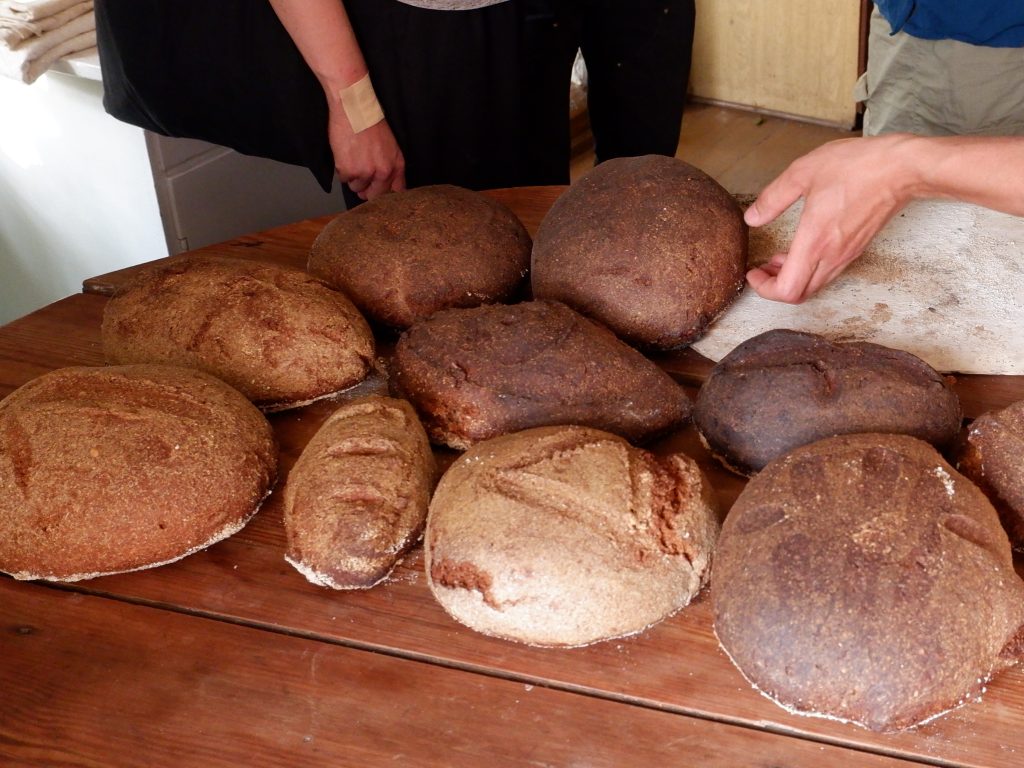
The second research trip of the Alternative Education Programme took place in the picturesque countryside of Dzūkija. Nature and traditional crafts inspired them as they foraged for wild berries in the forest, baked bread in a traditional oven, and tried folk wool felting technique. At the heart of their visit to Verpėjos (The Spinners) was a collective bread-making, where the AEP participants not only learned the intricacies of dough mixing and kneading but also embraced the value of slowness and listened to the fascinating stories about the process and historical background present in perfecting the traditional baking technique. The exploration extended to Marija Marcelionytė-Paliukė’s personal exhibition, About Snails and Ants, held at Marcinkonys Station Gallery. The trip concluded with a communal reading session dedicated to laziness and slowness, where artists gathered to share enchanting stories, articles, or poems. All this, surrounded by the evening fogs and the soothing steam from the traditional sauna, was a powerful reminder that stories, which guide our realities, never truly end but linger on.

The third workshop started with an open lecture titled The Hidden Turn: Secrecy, Double-Meaning, and Encryption, by Jason Bahbak Mohaghegh, exploring the rare trespasses at the heart of cryptographic thought: that is, where every idea forms a cipher, every word its own terrible or wondrous code, and where every sensation misleads one through endless trap doors, false steps, and uneven territories. Following his lecture, we embarked on a thrilling two-day workshop. Together, we delved into the fascinating conceptual territories of ILLUSION. Throughout the workshop, we ventured into the depths of history, tracing the enchanting tales of illusion across time. Witnessing the creativity and imagination of our fellow participants, we were awed by their intricate selections of mesmerising examples from artistic cultures worldwide, forming an archive of the unreal.
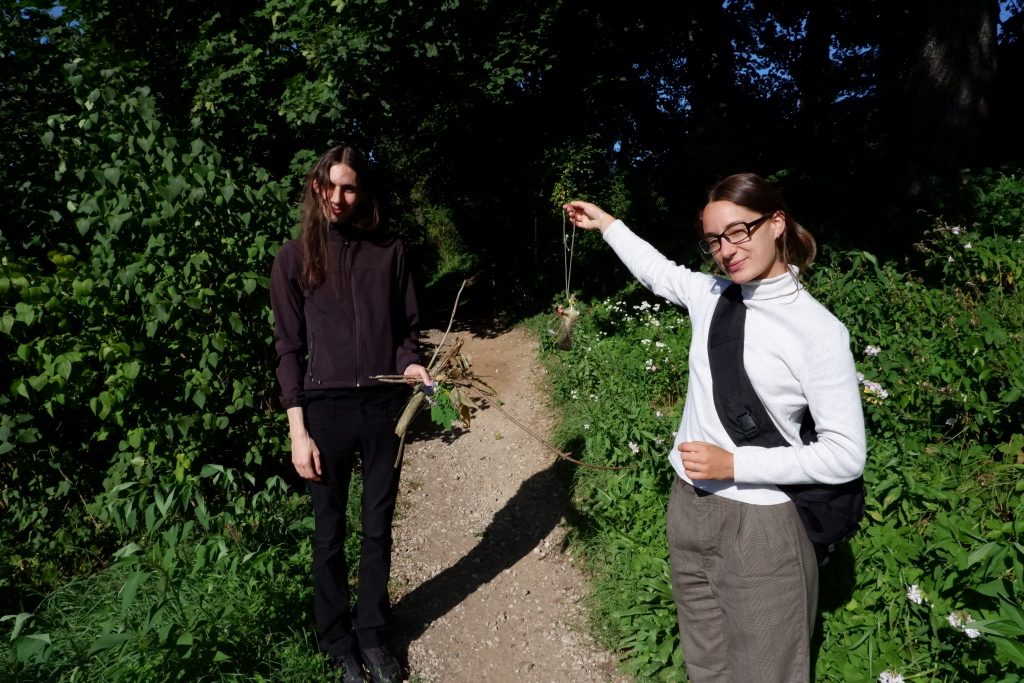
During the two-day workshop titled Thresholds and Landscapes led by Ayesha Hameed, our programme’s participants explored the consequent notions of subjectivity, interiority, and forms of memory. The fourth workshop was held at our location in Valakampiai. The surrounding area of Neris river served as an ideal site for the participants to explore methods of narrating the landscape in the ever-shifting natural environment.
Through interdisciplinary approaches, such as collective writing and sharing elements of a narrative assembled from the readings and walk, participants were encouraged to embrace decentralised knowledge exchange and process-oriented research. The workshop considered the threshold between land and sea and the meditative quality of being at the shore.
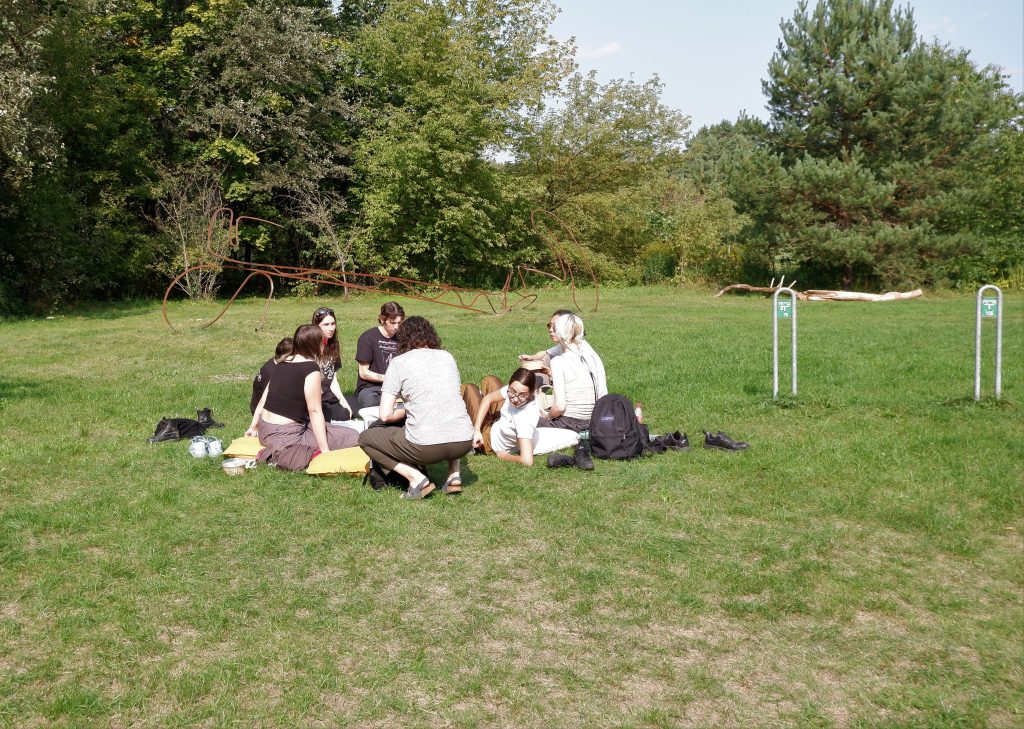
Gary Zhexi Zhang’s book launch for Catastrophe Time! marked the start of the fifth workshop, where the participants met the artist for a one-day workshop. By diving into the worlds of finance and time, the group engaged in discussions about the consequences of one world replacing another and sharing its relations to the artistic practices participants are working on. With the insightful look back on Catastrophe Time!, the AEP’ies have speculated on what kind of institutional, artistic, and cultural futures can emerge from the multipolar worlds reaching our way.

The end of September was generous enough to let us meet Ren Loren Britton and Iz Paehr, working together as MELT. Art design duo came to Vilnius to share their practice surrounding trans* feminism and anti-ableism, and by presenting their project Rituals Against Barriers, they invited the participants to perform them and create their own ones by reflecting on the microaggressions and oppressions we encounter daily. Besides the latter, combined with the inevitable, attentively curated selection of readings, the AEPies had a chance to reflect on their own practices combined with the insights collected. By leaning on the metaphorical concept of wedges MELT is working with, each participant produced a wedge connected to their practice – may it be a letter frozen into a block of ice, a tense web made of fabric keeping the door open, or a intangible sonic wedge exploring the tangible places. Ren and Iz said there were as many teachers in that room as there were people, which felt like an undeniable truth. Glad that MELT came to share their ideas with us and made room to exchange ours at the very right time.

Surrounded by the autumnal winds and shivering leaves, one morning in early October Rupert AEP participants have gathered by the Šnipiškės neighbourhood, and Relics of an Unfinished World has come into existence – a two-day exploration with visual artist Anastasia Sosunova where, as the artist herself has emphasised, the tutor is the neighbourhood itself. By wandering around Šnipiškės among Vilnusians known as Shanghai, together with the help of the urban researcher Jekaterina Lavrinec, we were trying to hear the stories told by the environment and study the histories surrounding it with specific methods given by the urbanist – the wooden houses built by the end of the nineteenth century contrastingly coming into dialogue with the skyscrapers standing on the right shore of Neris was a helpful starting point. As the afternoon came, we found ourselves in Anastasia’s studio, looking at some visual relics while munching on traditional Lithuanian biscuits — the essentially cosy autumn times. The study continued the next day as we stepped on the lands of Turniškės and Valakampiai, prominently known for accommodating the power places – presidential houses and the residences of diplomats. The conversations that arose from juxtapositioning those contrasting environments from this two-day journey found their place in the shape of the writing exercise suggested by Anastasia and some wrapping-up chats with the hot plate of collectively made mushroom soup.

Partial common ownership, mechanism design and plural voting systems – from never-heard-of-before to familiar in two workshop sessions with Matt Prewitt – the President of RadicalxChange foundation, advocating for the next-generation political economies.
In this very first online learning gathering of this year, AEP participants together with Matt tried to dismantle the concept of an institution and indicate the pathways to improve it. One of the possible tools presented is a plural voting system, also known as quadratic voting – “a redesigned voting method reflecting the intensity of people’s preferences in collective decisions”. We are pleased to announce that we are implementing this method into the curatorial processes of preparation for the very final exhibition of the programme.
In the Zoom workshop on Concept Engineering, the AEP participants collectively immersed themselves in a curated selection of concepts developed by artist Zach Blas. The workshop, designed with an impersonal and virtual approach, featured pre-assigned readings that participants engaged with before the session. Through a combination of insightful readings, Blas’s lecture, and group discussions, the workshop provided a platform for a shared exploration of these conceptual landscapes.
The virtual setting facilitated an inclusive exchange of ideas, allowing participants to dissect the readings and their implications collectively. The workshop, with its blend of theoretical exploration and practical discussion, offered a unique platform for our group to engage with and reflect upon the intricate world of Concept Engineering.
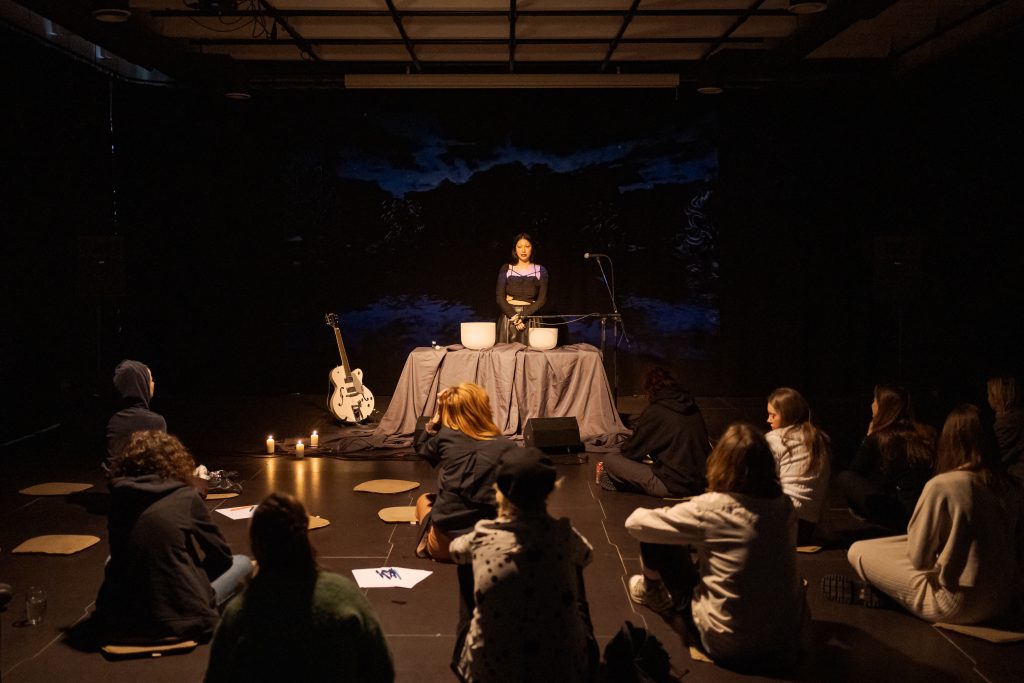
The last workshop of this year’s AEP programme was held by Rieko Withfield’s, in the workshop Songwriting Seance the participants found themselves immersed in a transformative experience, guided by a series of meditation sessions, enveloping bass frequencies, and automatic writing exercises crafted to tap into the depths of their inner voices. The workshop wove together these elements, providing a collective space for participants to explore and channel their most authentic selves.
Throughout the session, the group delved into the meditative journey, where healing bass frequencies served as a catalyst for introspection. Automatic writing exercises further fueled the creative process, unlocking a reservoir of personal expression. The culmination of these activities manifested in impromptu performances, featuring songs or spoken word poems that became conduits for collective energies.
The collective spells cast during these performances were intentional and resonated with themes of rebirth, embodiment, and the exploration of alternative futures. The workshop, experienced as a shared endeavour, allowed participants to connect with their creative instincts and contribute to a collective tapestry of expression.
In the aftermath of Songwriting Seance, the group left with a sense of having embarked on a communal journey, having harnessed the power of creativity to shape and envision new possibilities. The personal yet collaborative nature of the workshop emphasised the transformative potential inherent in the exploration of one’s innermost self within a collective setting.
Workshop Bibliography
Jason Bahbak Mohaghegh
El Wardany, Haytham. The Book of Sleep, 2021.
El-Wardany, Haytham . “The Book of Sleep — Haytham El-Wardany (Trans. Robin Moger).” minor literature[s], February 12, 2018. https://minorliteratures.com/2018/02/12/the-book-of-sleep-haytham-el-wardani-trans-robin-moger/.
Ayesha Hameed
Taussig, Michael. “The Beach (a Fantasy).” Critical Inquiry 26, no. 2 (2000): 249–78.
https://www.jstor.org/stable/1344123.
Taussig, Michael. “Excelente Zona Sociale” Cultural Anthropology, Vol. 27, Issue 3, pp.
498– 517.
Calvino, Italo. Cosmicomics. New York: Harcourt Brace Jovanovich: 1976.
Calvino, Italo. Invisible Cities. London: Vintage Classics: 1997.
Rushdie, Salman. Satanic Verses. London: Vintage, 1998.
HP Lovecraft. The Call of Cthulhu and Other Weird Stories. New York: Penguin Books,
1999, 139–69.
Screenings:
Antarctic Digital Heritage. 2020. “Antarctica – Encounters at the End of the World. Documentary.” YouTube. https://www.youtube.com/watch?v=6BB3YRtzRxE. Werner Herzog Reset d Alberta Whittle
Taussig, Michael. Fieldwork Notebooks. Hatje Cantz Verlag, 2011.
Gary Zhexi Zhang
Chakrabarty, Dipesh. “The Climate of History: Four Theses.” Critical Inquiry 35, no. 2
(January 2009): 197–222. https://doi.org/10.1086/596640.
Mbembe, Achille. “How to Develop a Planetary Consciousness.” www.noemamag.com,
January 11, 2022. https://www.noemamag.com/how-to-develop-a-planetary-consciousness/.
Zhexi Zhang, Gary . “The Artist of the Future.” artreview.com, 2020. https://artreview.com/back-to-the-drawing-board/.
Zhexi Zhang, Gary. Catastrophe Time! MIT Press, 2023.
MELT
Acosta, Navild, Sosa, and Naeem Douglas. “Black Power Naps: La Biblioteca Is Open | MoMA.” The Museum of Modern Art, 2023. https://www.moma.org/calendar/exhibitions/5551.
Emily May. “Expressing Rage through Angles and Pie Charts with Berlin-Based Artist Christine Sun Kim.” Friends of Friends / Freunde von Freunden (FvF), August 9, 2019. https://www.friendsoffriends.com/art/berlin-christine-sun-kim/.
Hamraie, Aimi, and Kelly Fritsch. “Crip Technoscience Manifesto.” Catalyst: Feminism, Theory, Technoscience 5, no. 1 (April 1, 2019): 1–33. https://doi.org/10.28968/cftt.v5i1.29607.
Kampnagel Hamburg. “Protestgespräch Mit Udo Sierck:»Jedem Krüppel Seinen Knüppel«.” www.youtube.com, 2023. https://www.youtube.com/watch?v=SDo9n_QloRQ.
MELT (Ren Loren Britton and Iz Paehr). “ACCESS SERVER: Dreaming, Practicing and Making Access.” First Monday, January 16, 2023. https://doi.org/10.5210/fm.v28i1.12908.
MELT, Loren Britton, and Isabel Paehr. “Con(Fuse)Ing and Re(Fusing) Barriers.” A Peer-Reviewed Journal About 10, no. 1 (August 13, 2021): 70–83. https://doi.org/10.7146/aprja.v10i1.128188.
Meltionary. “Rituals against Barriers.” meltionary.com, n.d. http://meltionary.com/meltries/a.html#:~:text=Overview.
Moesch, Jarah. “The #CripRitual Care Package.” #CripRitual, February 2022. https://cripritual.com/care-package/.
Public Delivery. “Why Do Adrian Piper’s Calling Cards Still Matter?” Public Delivery. Public Delivery, August 11, 2019. https://publicdelivery.org/adrian-piper-calling-card/.
Anastasia Sosunova
Stewart, Kathleen. “Weak Theory in an Unfinished World.” Journal of Folklore Research: An International Journal of Folklore and Ethnomusicology 45, no. 1 (January 2008): 71–82. https://doi.org/10.2979/jfr.2008.45.1.71.
RadicalxChange (Matt Prewitt)
Chiang, Ted. “Exhalation.” Lightspeed Magazine, April 29, 2014. https://www.lightspeedmagazine.com/fiction/exhalation/.
George, Henry . “The Unbounded Savannah.” www.henrygeorge.org, n.d. https://www.henrygeorge.org/savannah.htm#:~:text=In%20this%20famous%20excerpt%20from.
Heidegger, Martin. “The Question Concerning Technology,” 1977. https://bpb-us-e2.wpmucdn.com/sites.uci.edu/dist/a/3282/files/2018/01/Heidegger_TheQuestionConcerningTechnology.pdf.
Prewitt, Matt, and Paul Healy. “THE HANDBOOK for RADICAL LOCAL DEMOCRACY V2.0,” n.d. https://www.radicalxchange.org/media/papers/The_Handbook_for_Radical_Local_Democracy.pdf.
Prewitt, Matt . “Democracy Actually Is Good at Governing Infrastructure, and Infrastructure Is Exactly What Democracy Should Govern.” RadicalxChange, September 7, 2021. https://www.radicalxchange.org/media/blog/democracy-actually-is-good-at-governing-infrastructure-and-infrastructure-is-exactly-what-democracy-should-govern/.
———. “Secret Societies, Network States, Burning Man, Zuzalu, and More.” RadicalxChange, August 22, 2023. https://www.radicalxchange.org/media/blog/secret-societies-network-states-burning-man-zuzalu-and-more/.
Zach Blas
Critical Art Ensemble, “Utopian Plagiarism,” The Electronic Disturbance, 1994.
Donna Haraway, “A Manifesto for Cyborgs”, 1985.
Édouard Glissant, “For Opacity”, 1990.
Paul Preciado, Contra-sexual Manifesto (excerpts), 2011.
Zach Blas, “Informatics of Domination”, 2017.
Zach Blas, “Informatic Opacity,” Posthuman Glossary, 2018.
Zach Blas, “Contra-Internet”, 2016.
Zach Blas, “Unknown Ideals”, 2021.
Exhibition

dismantling dreams, disrupted seams is the final show of the 11th edition of Rupert’s Alternative Education Programme (AEP). A closing chapter of a six month long learning process dotted with workshops, lectures, studio visits, crit sessions and other creative disruptions. Loosely guided by the theme of transgressions and traversability, the programme comes to an end at the now disused and previously publicly inaccessible administration building of a sewing factory Lelija. Eight new site-specific installations will briefly, but intensely transform the building before its inevitable demolition. A strong metaphor and symbolic gesture, best described by the words of one of the participants Rokas Vaičiulis:
In dismantling dreams, disrupted seams the distribution of the space and its creative inhabitants is established through mutual detachments. Each crevice reaches towards its own world and pitch among the separated, vacant offices of the voluminous former sewing factory’s bureau unit. Stretching through the three floors of the building, however, the crevices are not anymore separated by the labour hierarchy or their spatial function, rather, they act as patch-works to be experienced while steering through atmospheres and dialects that echo the clusters of shared sensoriums and pursuits. Subtracted from the shades of blue collar and the noise of fluorescent lights at maximum hum-buzz, each cabinet invites for an avid peek into the seamless pockets of processes and temporal wedges, a curious call to traverse through and into the ascending and descending structures, and imagine their interdependencies according to one’s own mental map.
For the opening on 24 November, the participants of AEP were joined by invited guests – Rieko Whitfield, Kerolaina Linkeviča, exmantera, Angelware and Matilda for a night of performances, music and dancing at the iconic hall of Lelija.
Work Descriptions
Rokas Vaičiulis
Unlived Experience, 2023
Video installation, steel hanger, t-shirt with print, cardboard ceiling panels
“What a digital machine is to an analogue one, Unlived Experience is to Lived Experience. You have (1) new notification(s)…”
By anchoring the plot of Unlived Experience in the mundane, the onscreen and the parasocial, Rokas Vaičiulis goes on a processual ride through the everydayness of thought and the thought of everydayness: diaristic entries, origin-lacking memetics, digital moodboard poetics, bootlegged tonalities – all embedded as inauthentic, artificial forms and flows.
An artefact of participation in the AEP, the video installation is an attempt to envisage the digitised commodity consumption as a moving image: a pendulum swing between the manifest and the impersonal, a speculative measure of its weight, velocity, luminosity.
For the archive of their texts, visit: hyacinthkatatonia.substack.com
Eglė Ruibytė
Team Spirits, 2023.
Expanded polystyrene, plastic film
A former accounting office becomes a space of uncertain purpose holding reminiscences of a lounge room or teambuilding space. Here, an unachievable team spirit sometimes shifts into a haunting corporate spook. The artefacts, created using cheap materials normally used for packaging and shipping but making them handmade and resembling corporate or festive symbols, turn into hints of longing, care, emptiness and exploitation.
Ella Jo Skinner
HGMITR, 2023
Multisensory installation, materials contain but are not limited to: wool, yarn, string, smoke, frankincense, objects and animal remains retrieved from a gopnik (chav) in Latvia, rat corpse preserved in resin, wax, plaster, silicone, resin, glucose, dirt, ink, religious paraphernalia obtained from a church in Tallinn, acrylic, industrial paint, hand altered prints of a historical painting sourced from Poland.
Sometimes, the girl snapped her phone off and looked at the sky. As she looked at the sky, she thought it to be the dull whites of the eyes of some ethereal dictator. Some dictator who wanted to see her squirm, who let her imprison herself. Torturing her with broken promises about the state of the cosmos. She drew a conclusion, one night on her phone, that if she had been around when humans existed in tribes, she would have been a wise woman or a priestess. She would have been raped and burnt at the stake for her wisdom. She cursed the sky. Convinced it had a consciousness she would fall back to sleep.
Lux Sauer
Cultivating Response-ability – Occupying Space by Ski Suit-ing an Artistic Dialogue, 2023
Ski suits, latex, birch tree bark, pine tree needles
The project started with the idea to inhabit different environments and vulcanise the location by incorporating both visual art and somatic components through translating elements of the volcano into a visual and choreographed exhibition, forming an immersive environment. Ideally the vulcanised space turns into a territory in which hanging out, belonging, conversations, spending time together and creativity burst the demarcations.
During the research process and artistic exploration I faced circumstances that provoked an urgent question: how to cultivate an artistic practice within a non-responsive environment? Or how to cultivate a space that can safely hold a creative process? How to cultivate response-ability?
Will Krauland
Two videos:
Lens B.C.12
Untitled3456
Two photos. Both UV prints on semi-gloss paper7:
Untitled
Sub (m)
Two found objects:
Untitled, a calendar for the next year (2024)8,
Untitled, a calendar that is a part of an old sign produced for JSC ‘Lelija’ found on the third floor of the administrative building.
Two beating metronomes910.
Two speakers11, but not here12.
And there13 is probably even more…
1 30 seconds…
2 see Synch.
3 300 seconds…
4 Pause frees us from time and space, from linear pleasures, from the sounds we expect, and enters another dark space…
5 from which there is no escape?
6 see Fastforwarder.
7 JSC ‘Jaunokas’ Spirit.
8 It seems that the office workers in the former factory seemed to love cat calendars. You’ll see if you walk through the basement.
9 A normal resting heart rate should be between 60 to 100 beats per minute… If your heart rate is over 100 beats per minute when you are at rest, this is considered fast… If you have noticed a sudden increase in your heart rate and are also feeling dizzy, faint or having palpitations (a feeling of being aware of your heartbeat, or that your heart is pounding or beating irregularly), you should speak with your GP… A heart rate below 60 beats per minute when you are at rest is considered slow… If a slow heart rate is not normal for you, especially if you feel unwell with it, this could indicate a problem with your heart. If you notice your heart rate is slower than usual, and you are feeling faint, fatigued or dizzy, you should talk to your GP… (copied from bhf.org.uk)
10 Here I found some ancient energies working alone and together… Emerging like little flourishes and spindly little ribbons of radiation…
11 3000 seconds…
12 Naugarduko g. 5, 01141 Vilnius
13 One should be in one’s own void. Void is silence. Solitude. An absence of relationships. . . . The void is a plant that must continually be watered. (F. J.)
Steph Joyce
Unlucky Star, 2023
Site-responsive narrative: audio (loop), found objects, linen textiles, light, water, heat, residue, desire
Dimensions variable
Stuck and stalling in the rising action.
A former accounting office becomes a space of uncertain purpose holding reminiscences of a lounge room or teambuilding space. Here, an unachievable team spirit sometimes shifts into a haunting corporate spook. The artefacts, created using cheap materials normally used for packaging and shipping but making them handmade and resembling corporate or festive symbols, turn into hints of longing, care, emptiness and exploitation.
Églantine Laprie-Sentenac
Guard (Please Do Not), 2023
Wire, tree protection, mesh fabric, cardboard, found object, laser
Dimensions variable
Guard thinks about the forms and materials of distancing, what is unreachable in and out.
Kamilė Krasauskaitė
holy wells
and trees & other faith-healing sites, 2023
installation
Places of power, healing, and human as well as non-human journeys, especially in liminal times – epidemics, wars, natural disasters – when human imperfections and limitations, and the need for the omnipotence of the Infinite, were felt most acutely.
In this spatial choreography of ritualised transactions, seekers of miracles and benevolent saints engage. Specific conditions are hidden in the landscape of faith, a cosmic barter where the saints, like mystic merchants, negotiate the price of miracles with those who earnestly turn to them.
Credits:
3D image concept and visualisation: Jurgis Lietunovas
Video editing: Kamilė Krasauskaitė and Vilius Vaitiekūnas
Scenography advisor: Barbora Šulniūtė
Massive thanks to: Eglė Kliučinskaitė, Marijonas Verbel, Aistis Kavaliauskas and Gustė Kripaitė
Rokas Vaičiulis. Unlived Experience


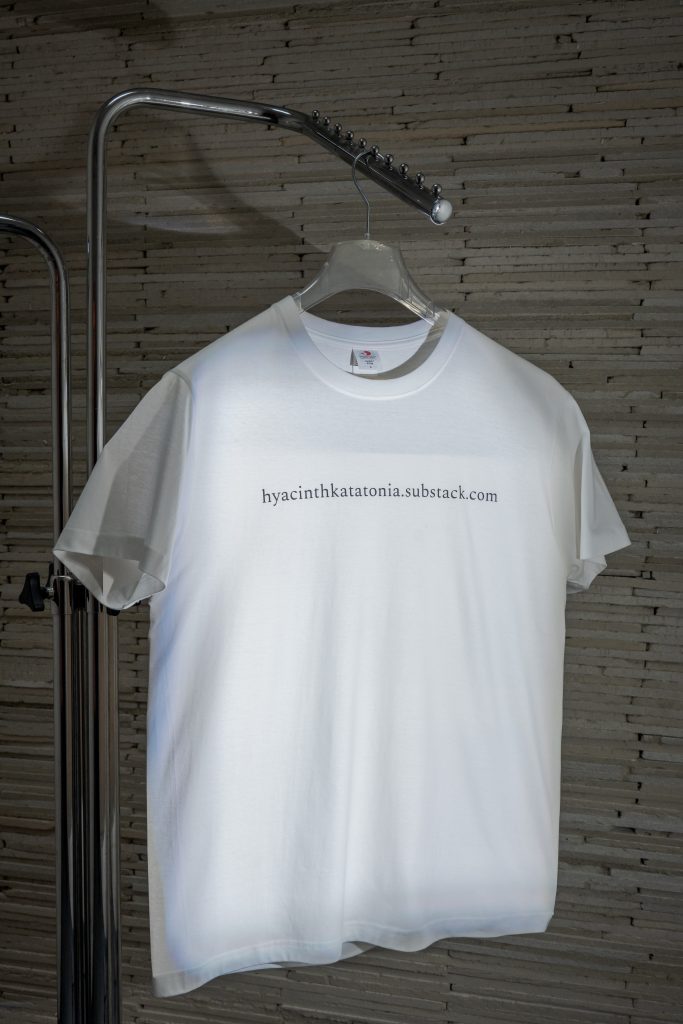
Eglė Ruibytė. Team Spirits


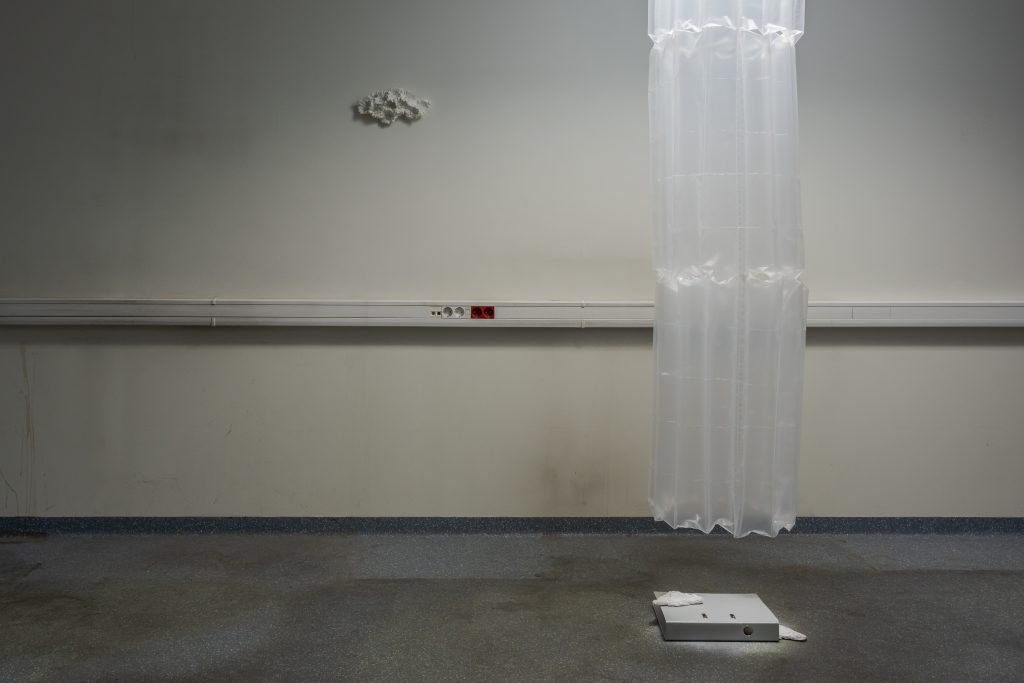

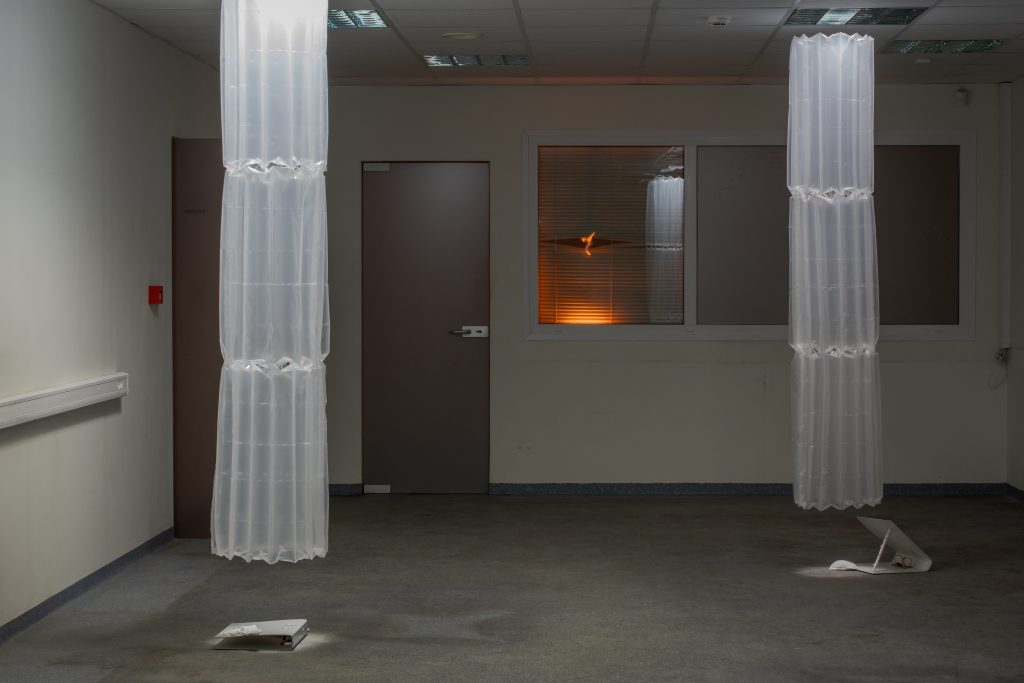

Ella Jo Skinner. HGMITR
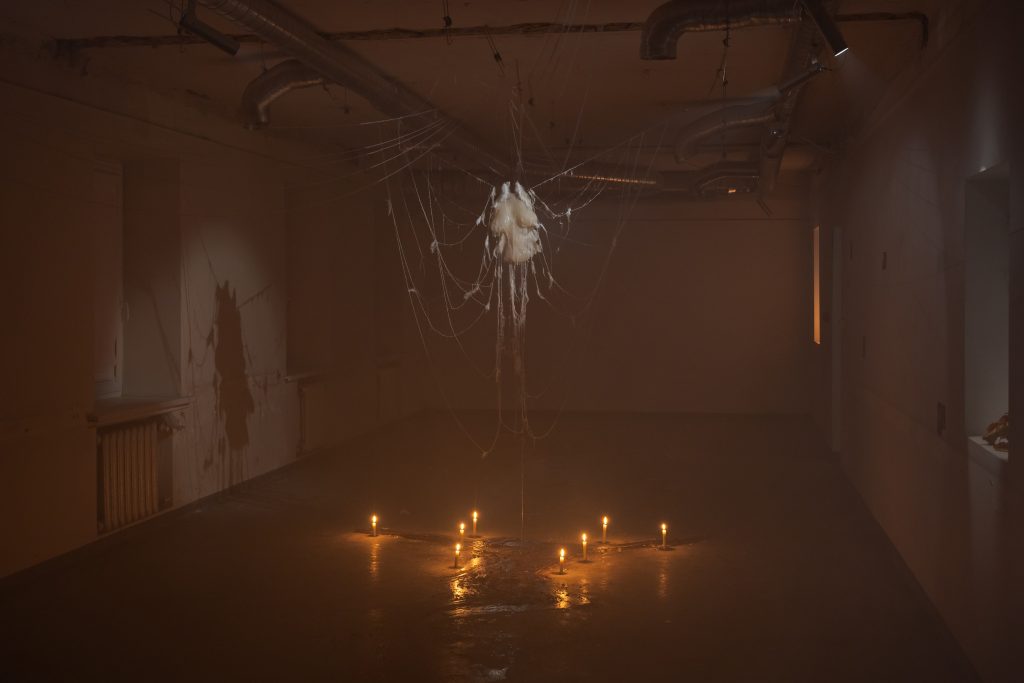
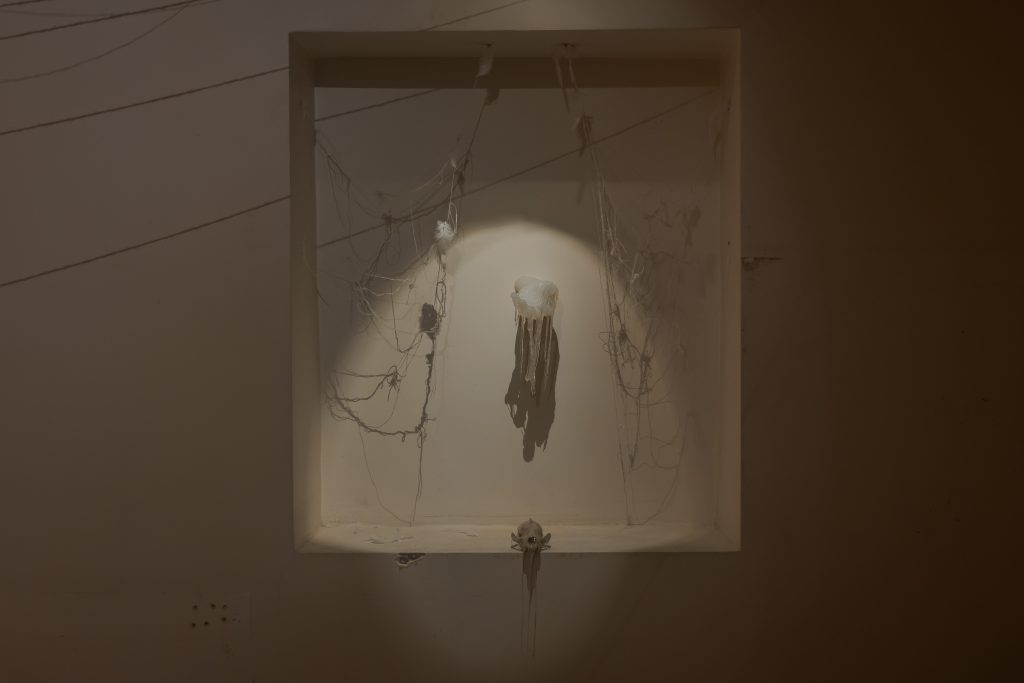
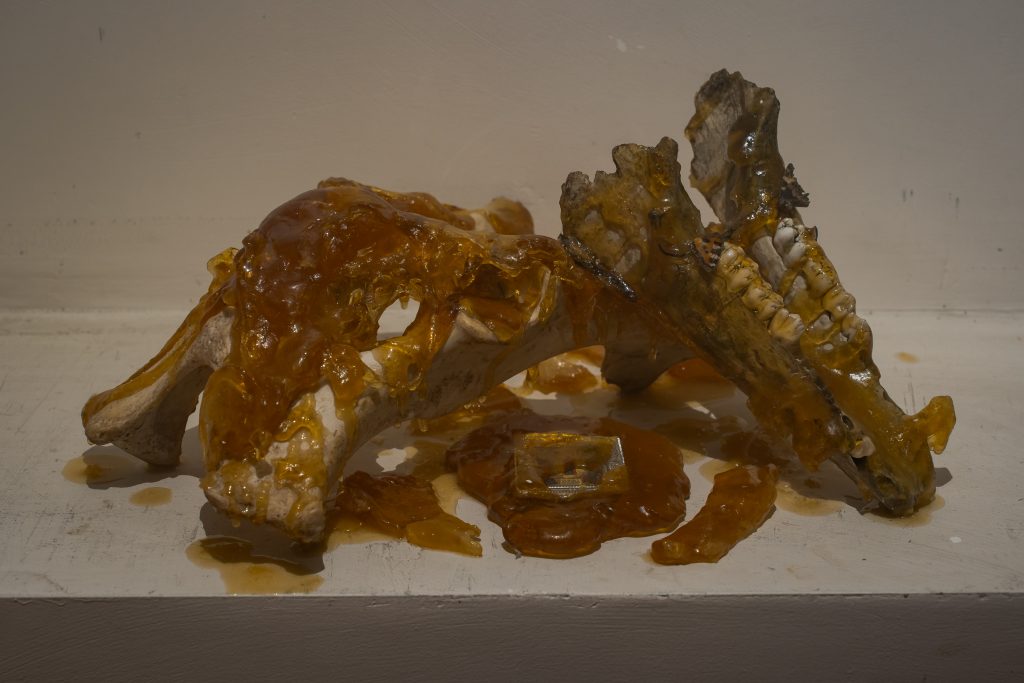
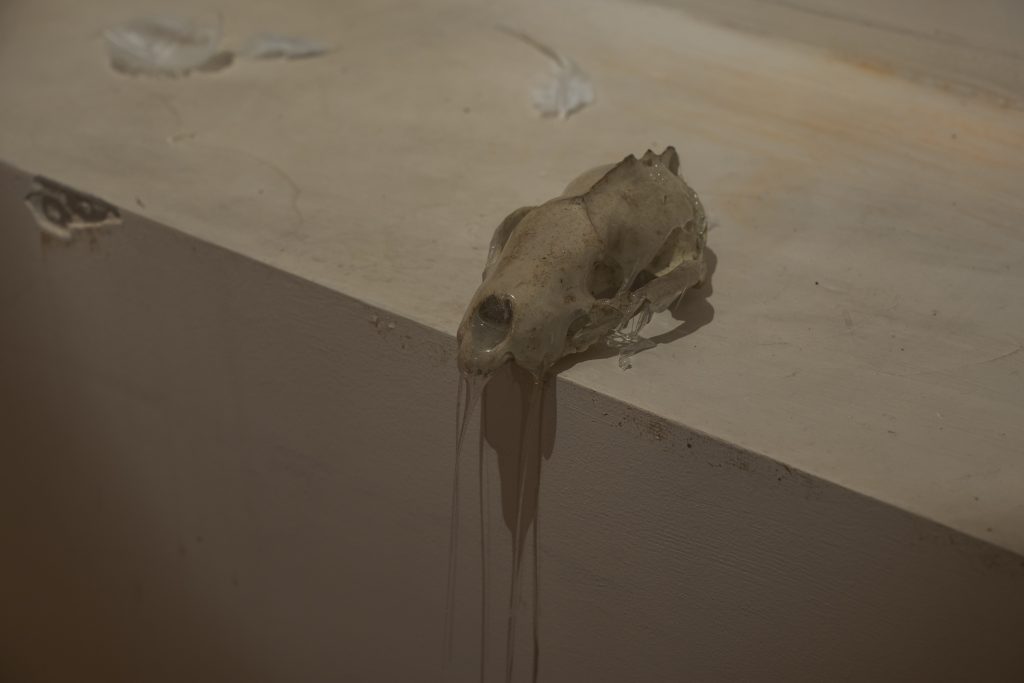


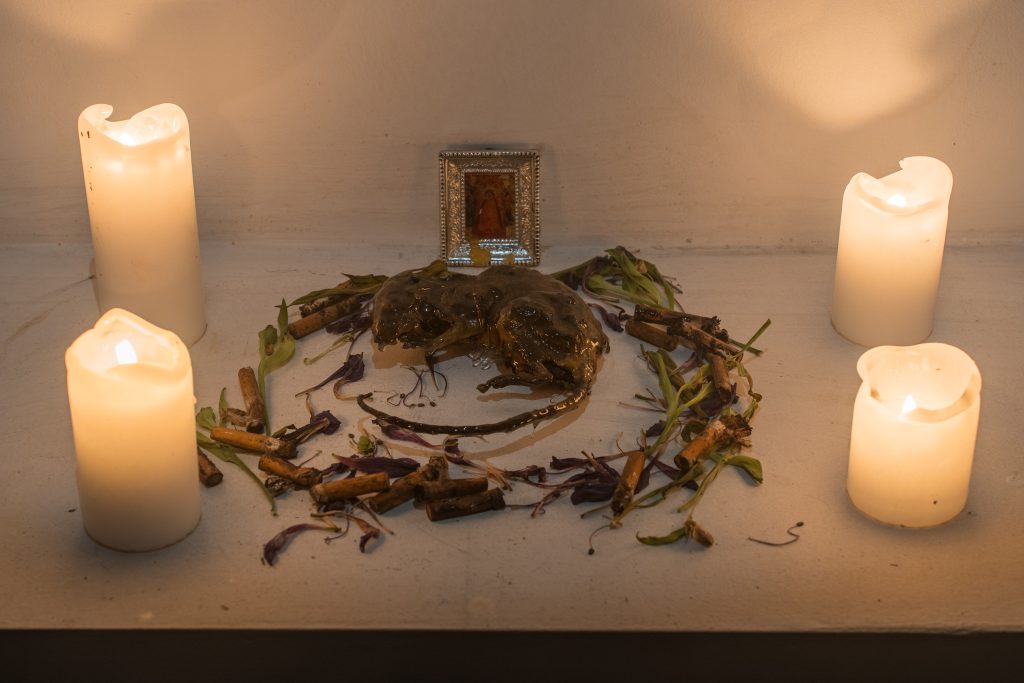

Lux Sauer. Cultivating Response-ability – Occupying Space by Ski Suit-ing an Artistic Dialogue
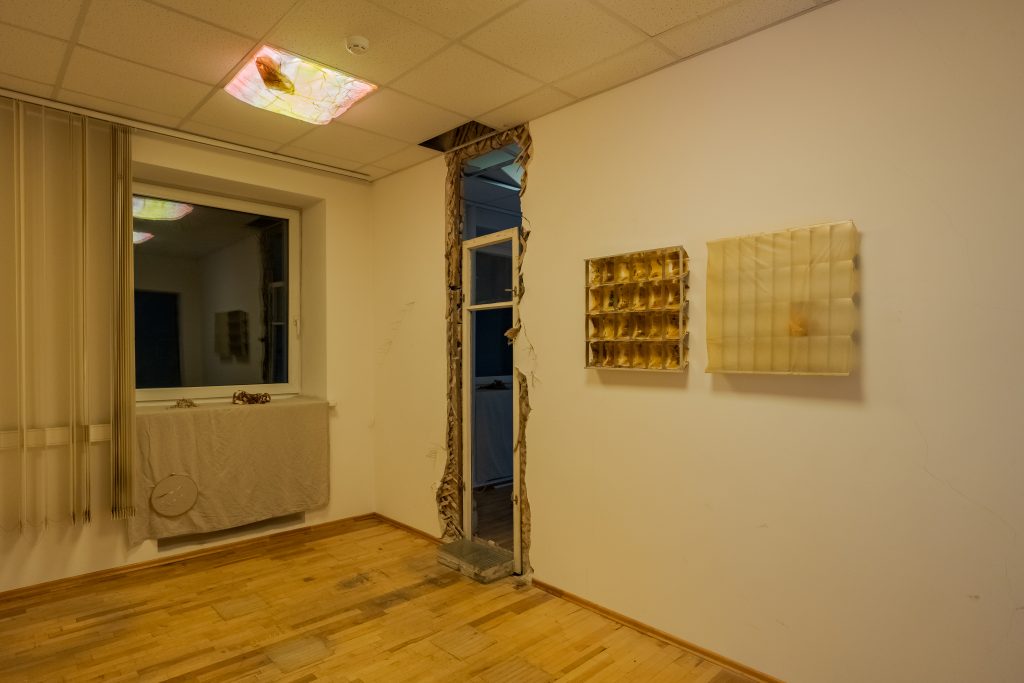
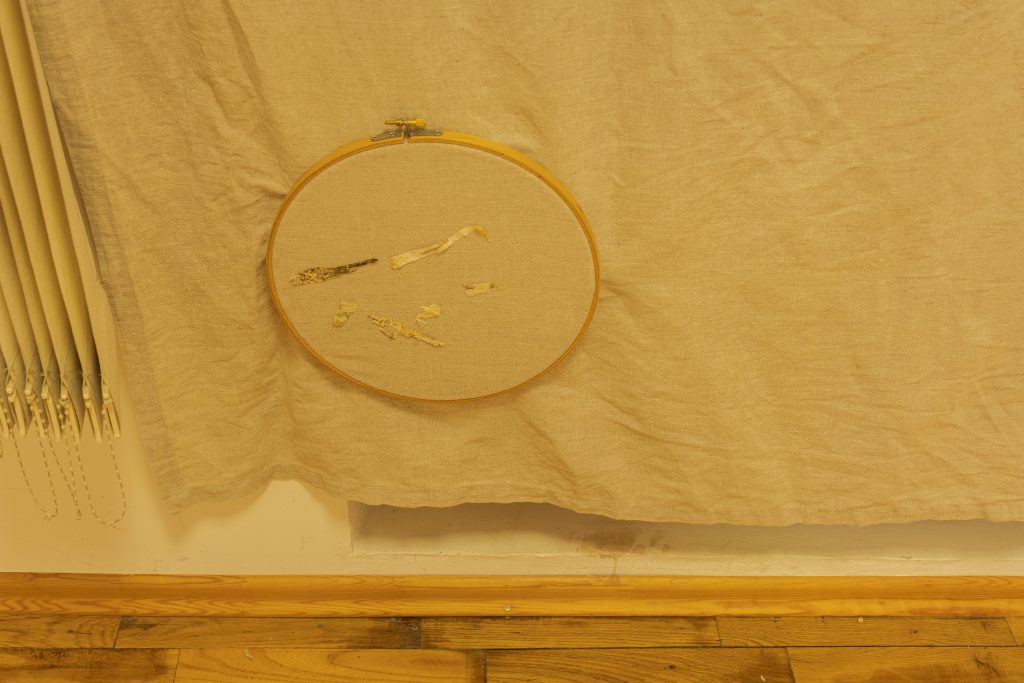



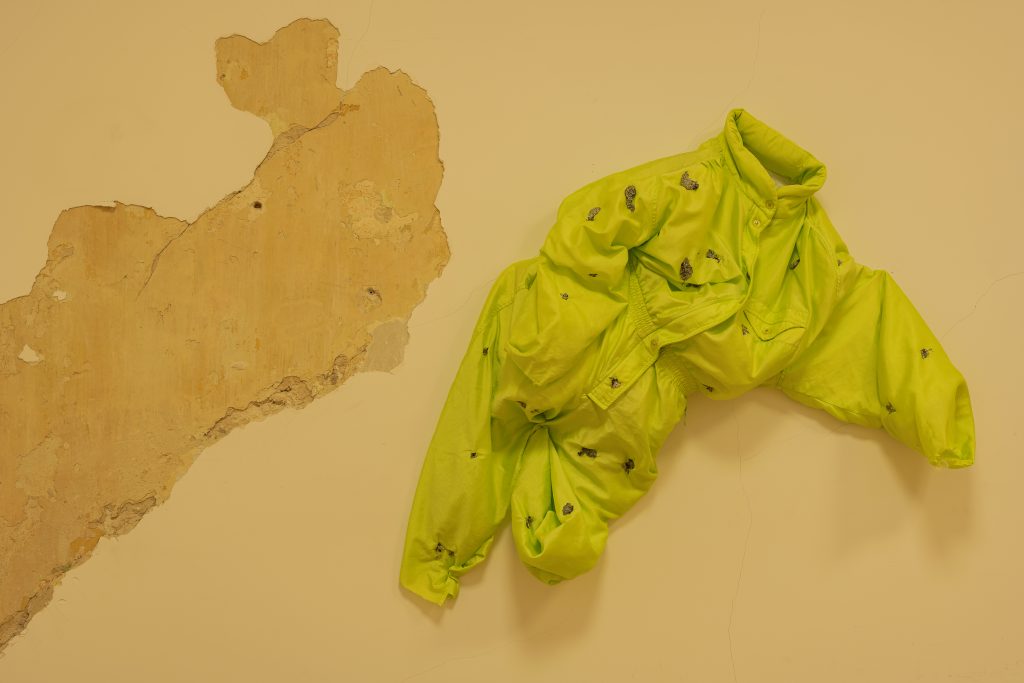
Will Krauland
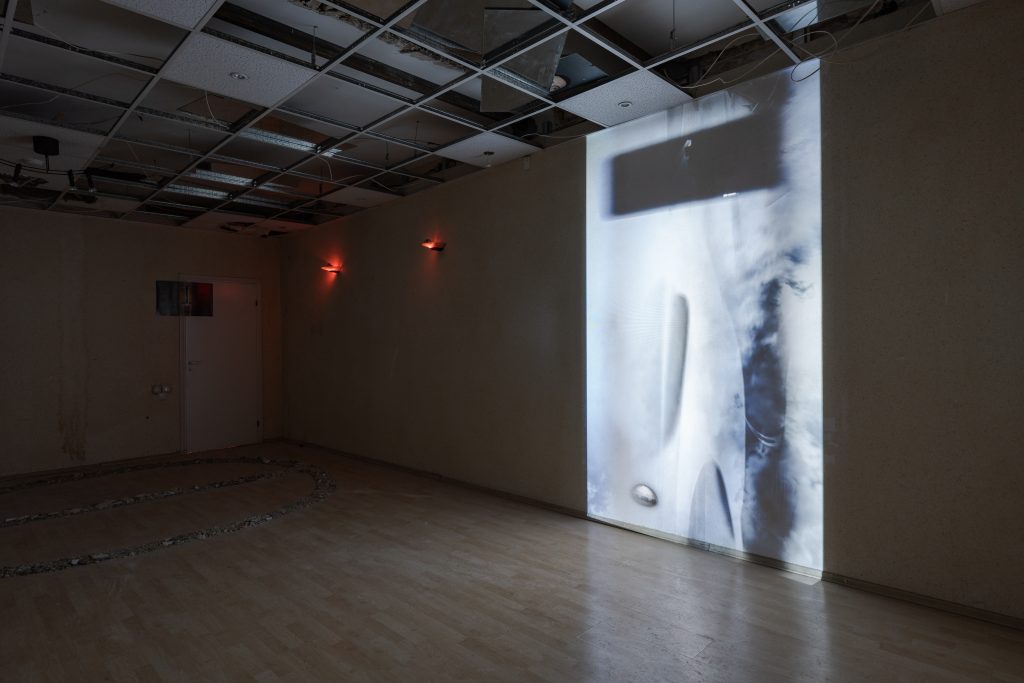
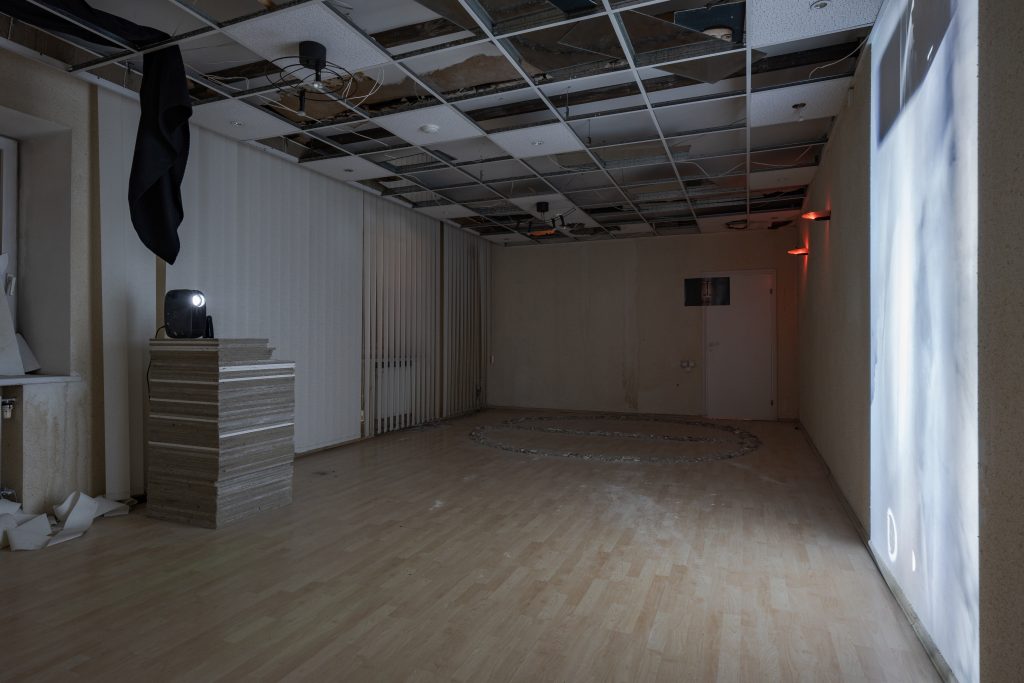
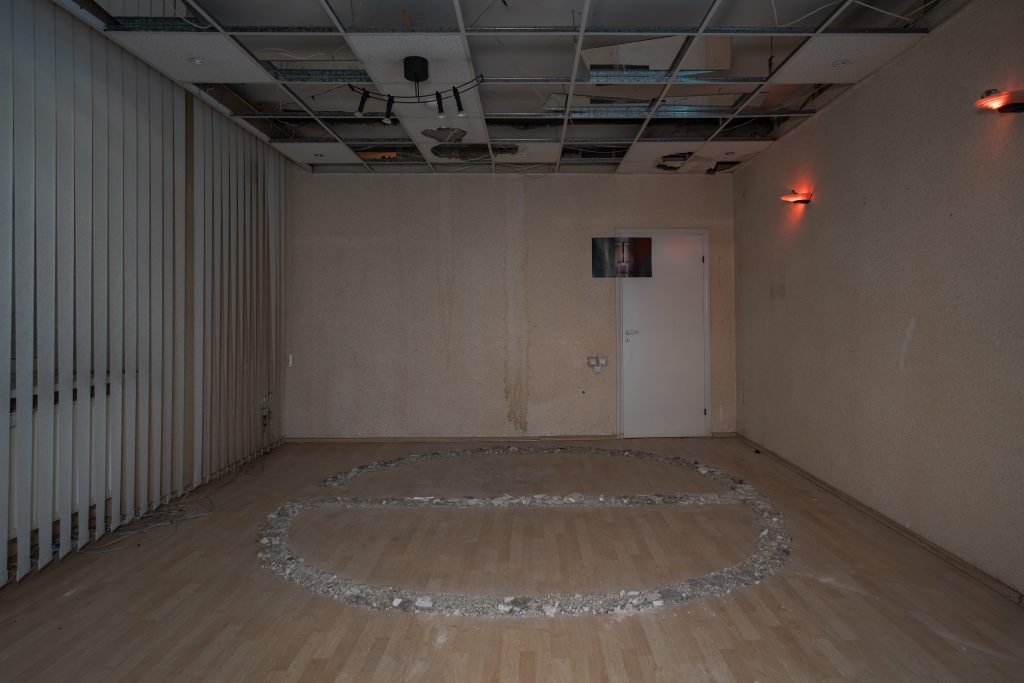
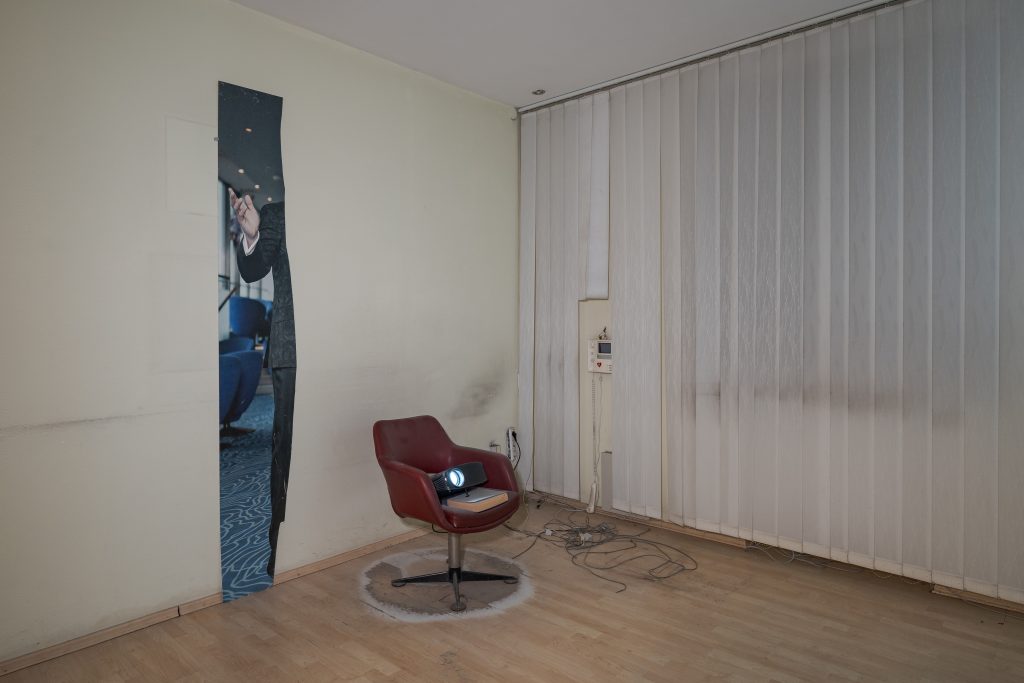
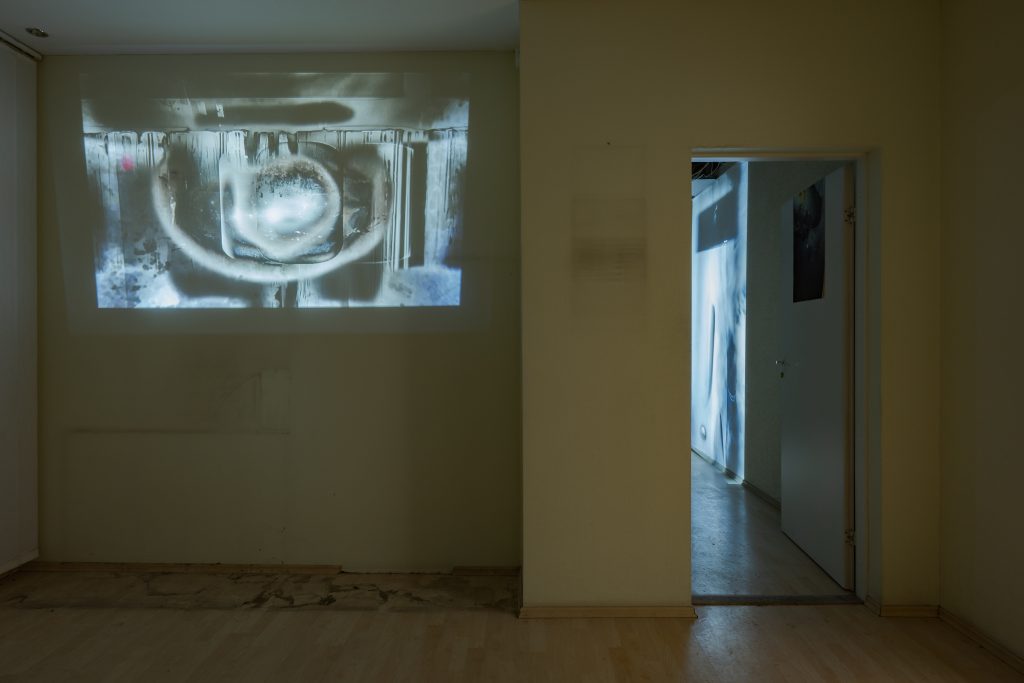
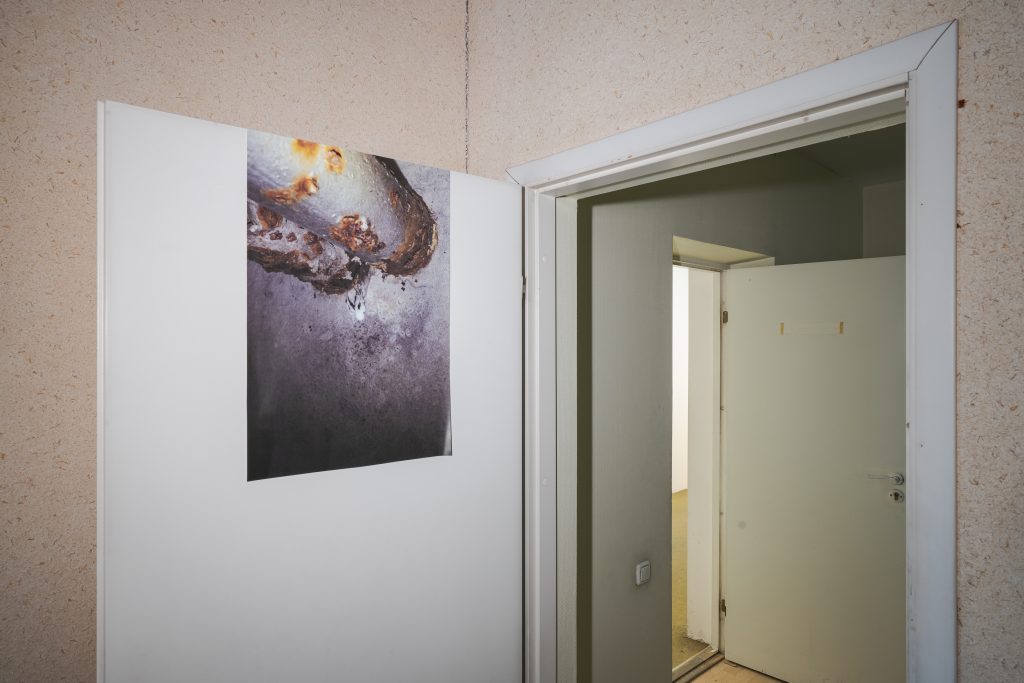
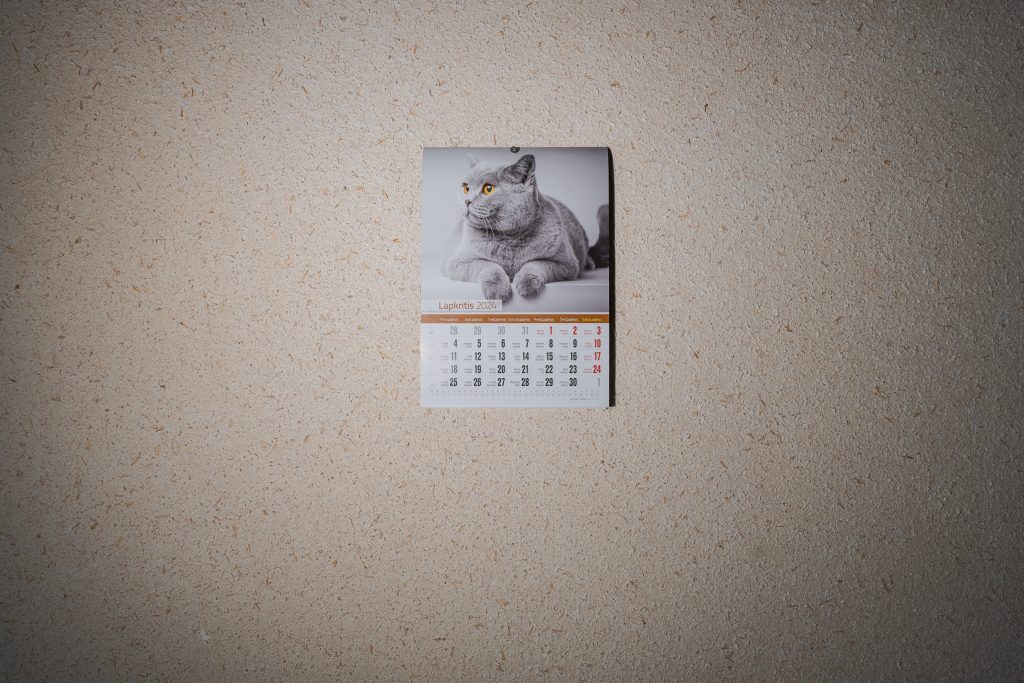
Steph Joyce. Unlucky Star
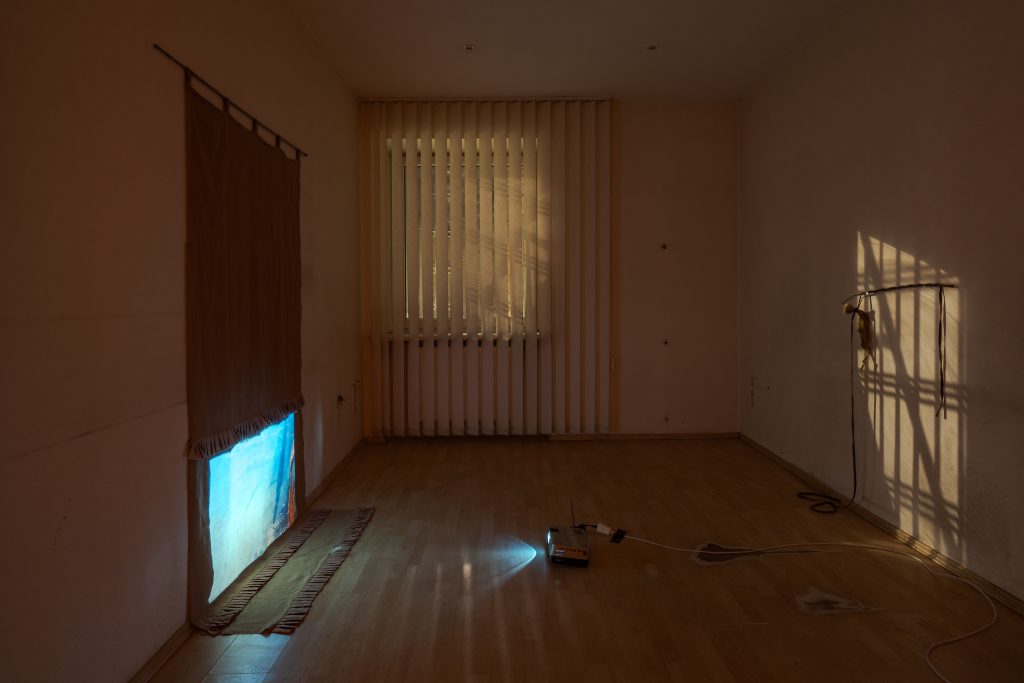


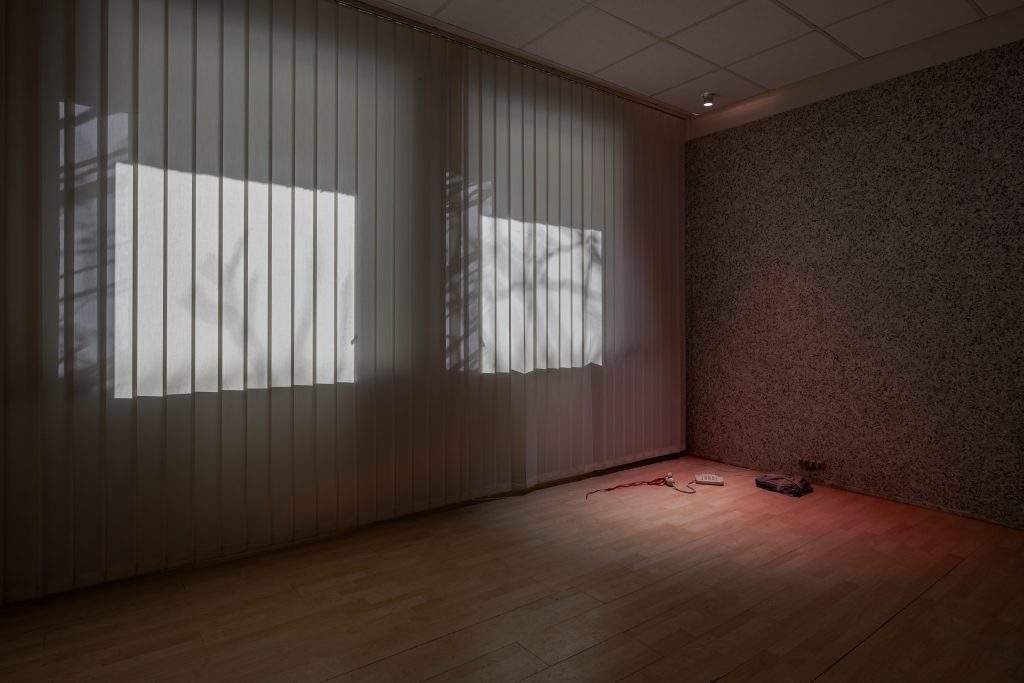
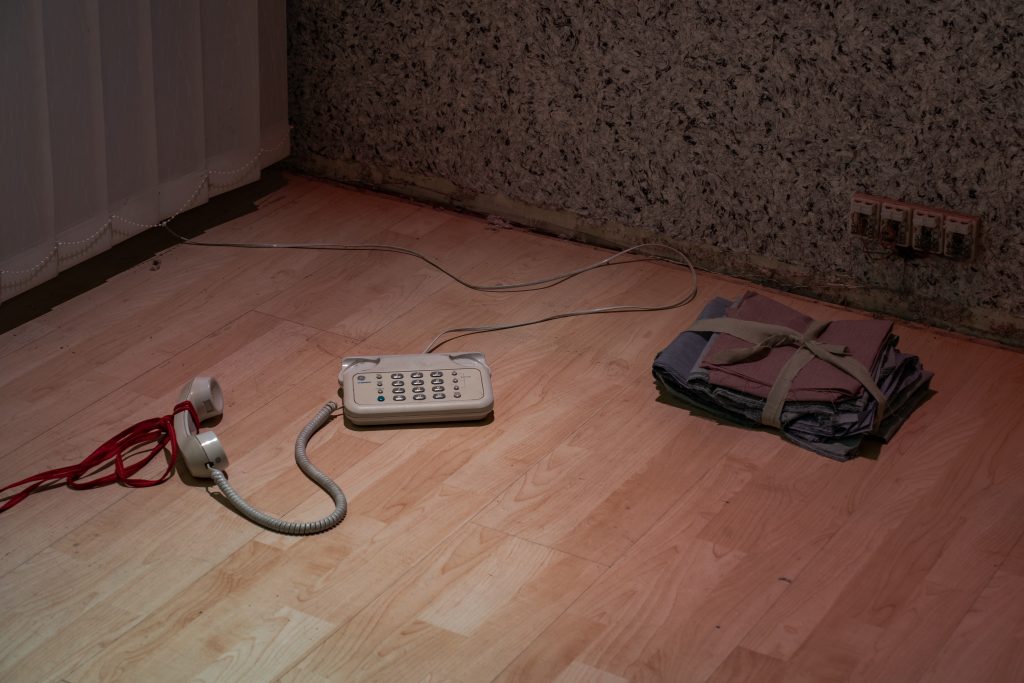
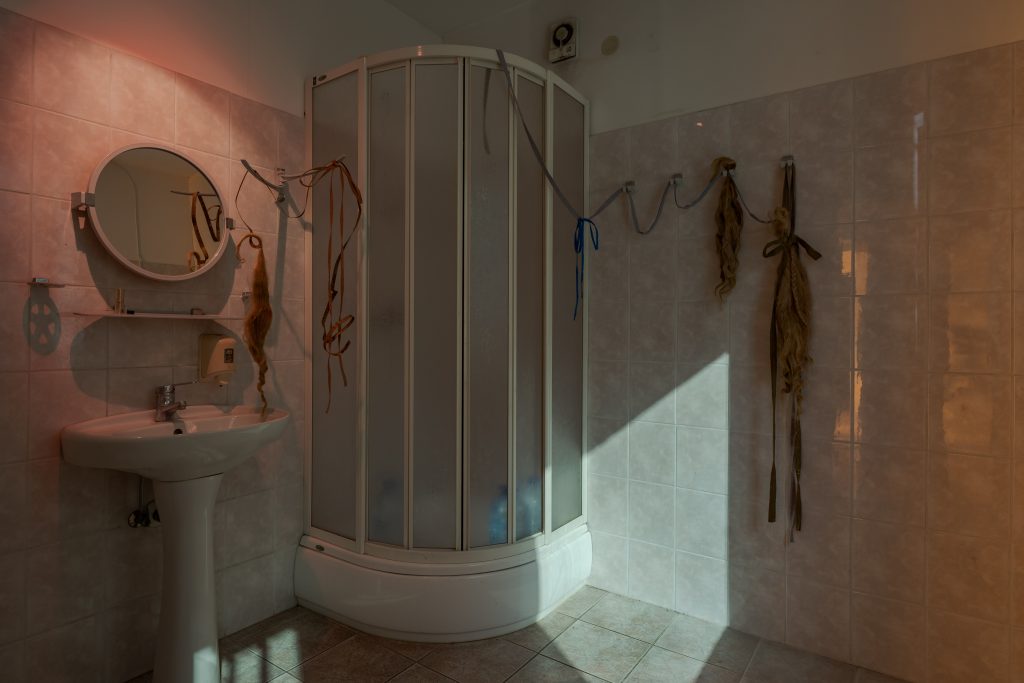
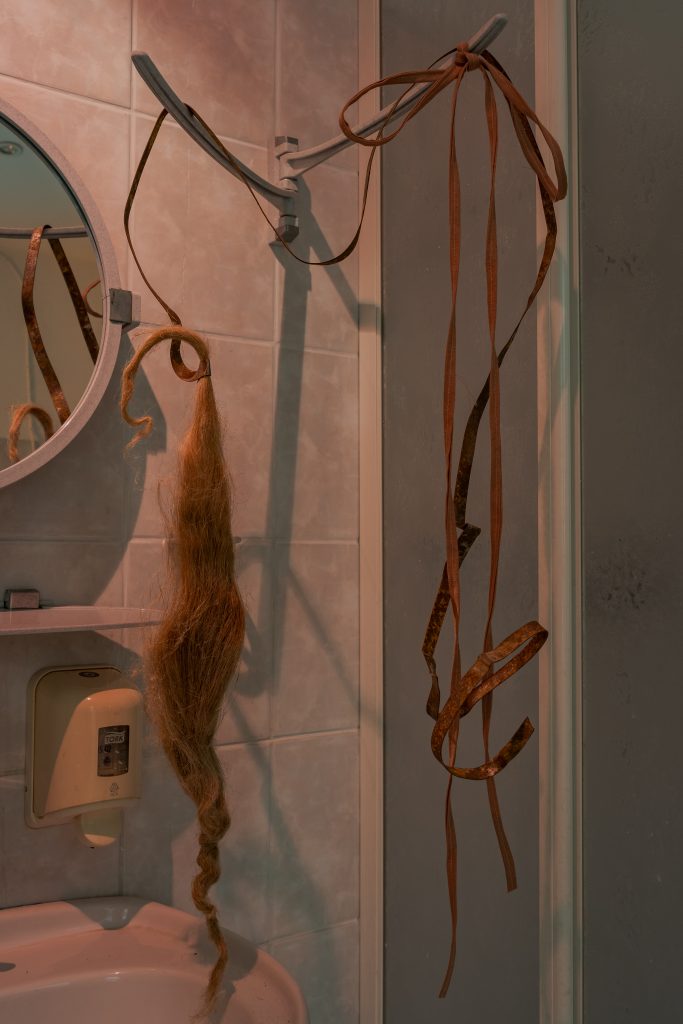
Églantine Laprie-Sentenac. Guard (Please Do Not)


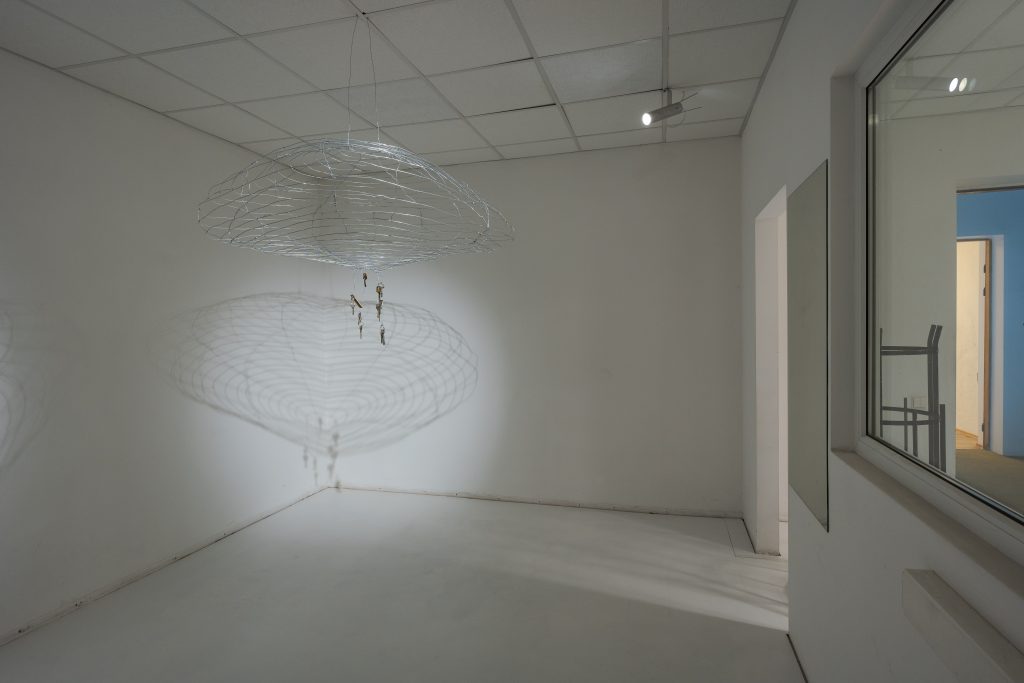
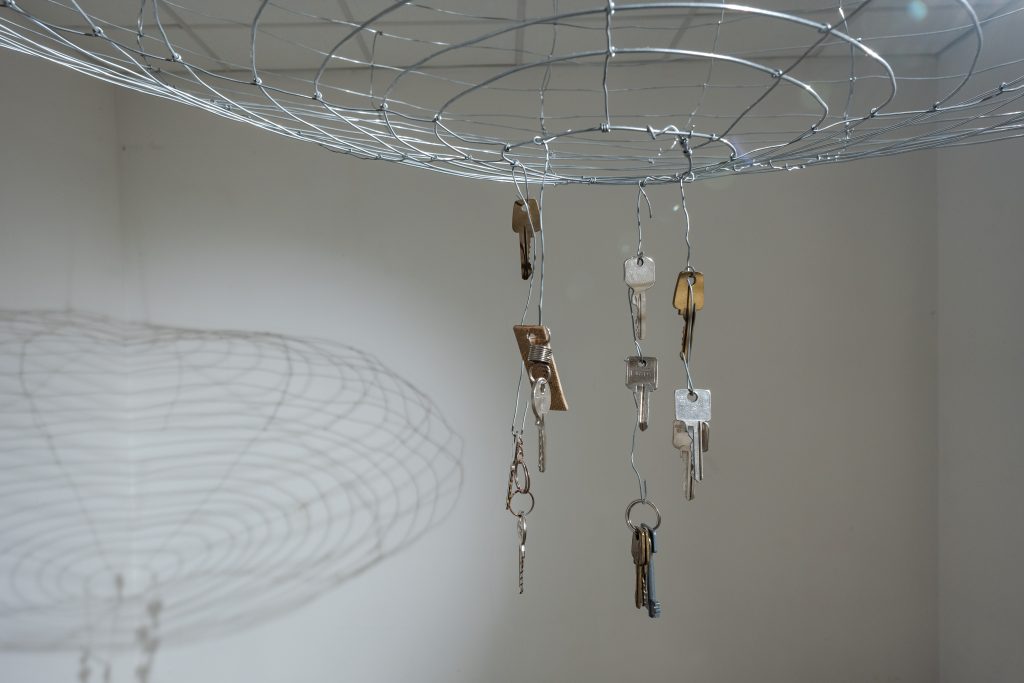
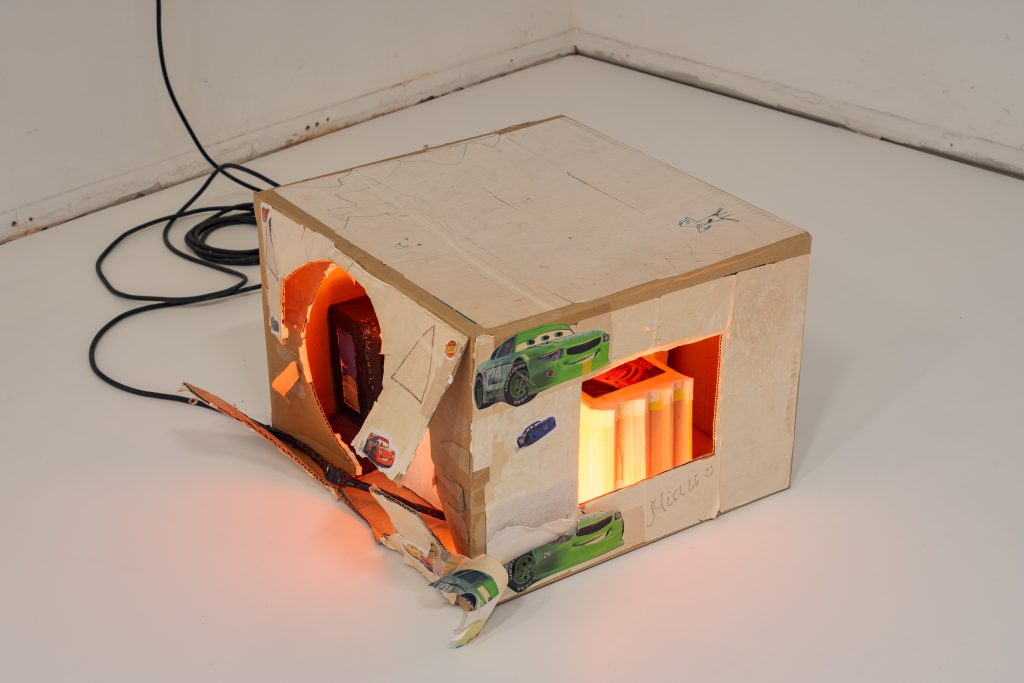

Kamilė Krasauskaitė. holy wells and trees & other faith-healing sites
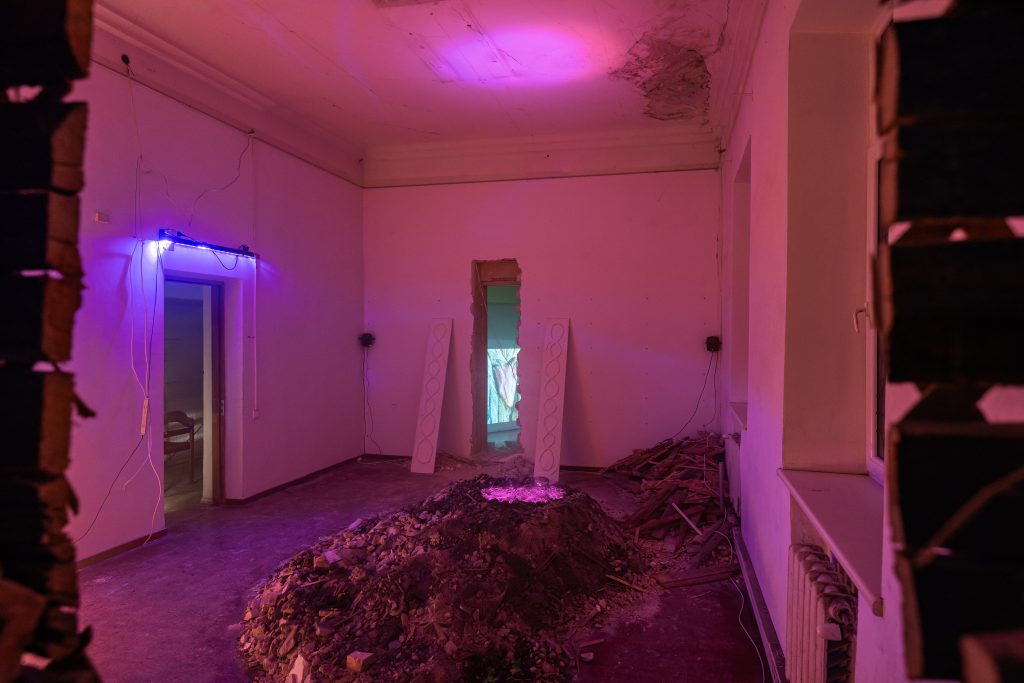
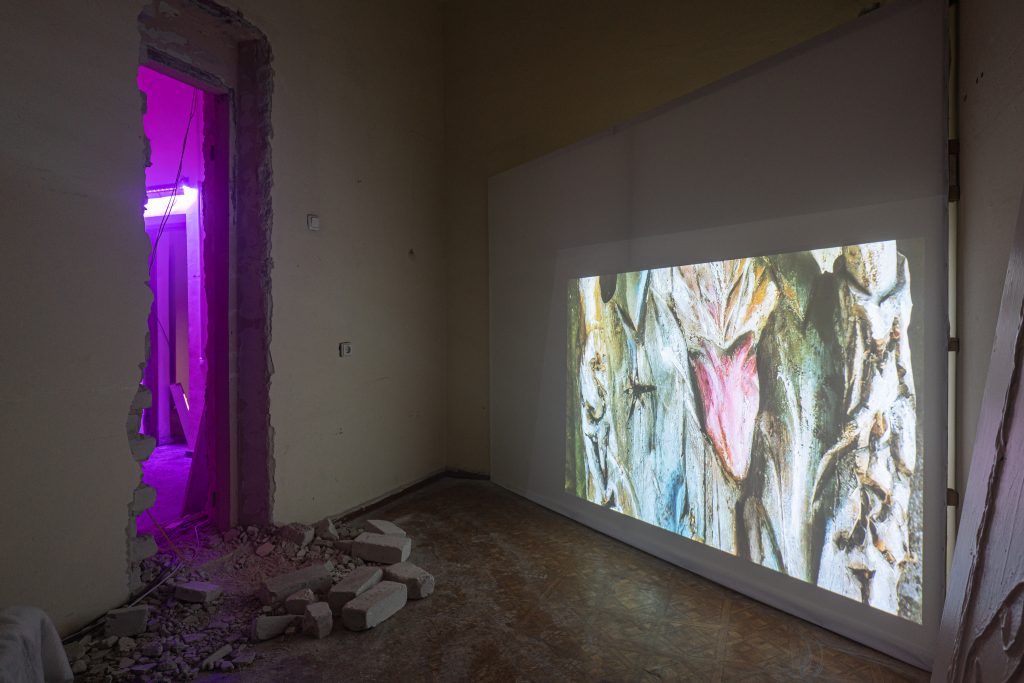


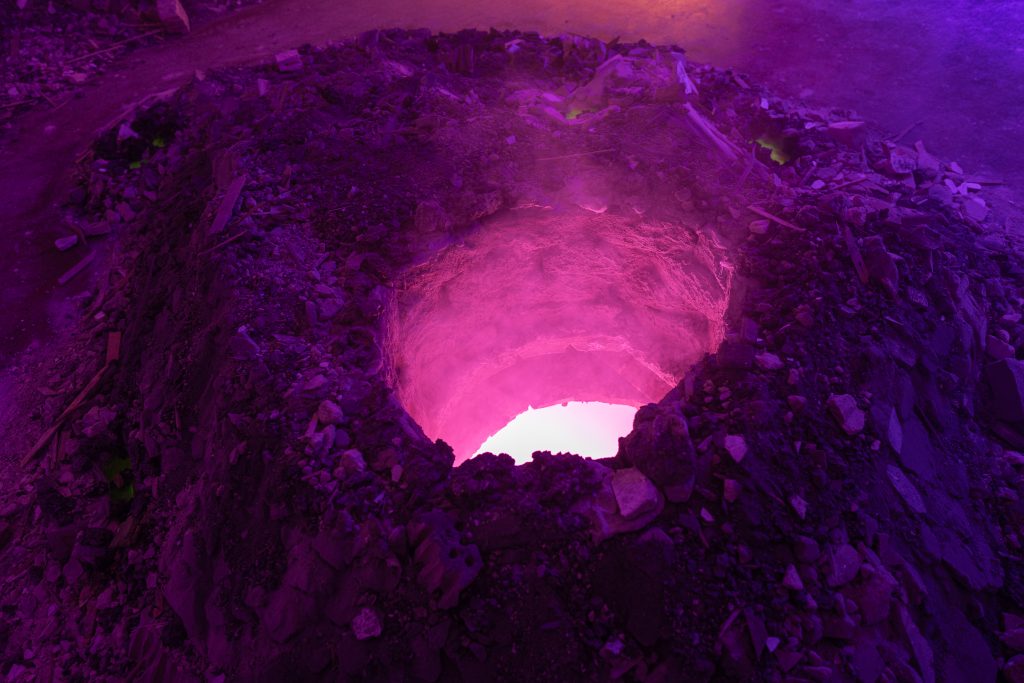
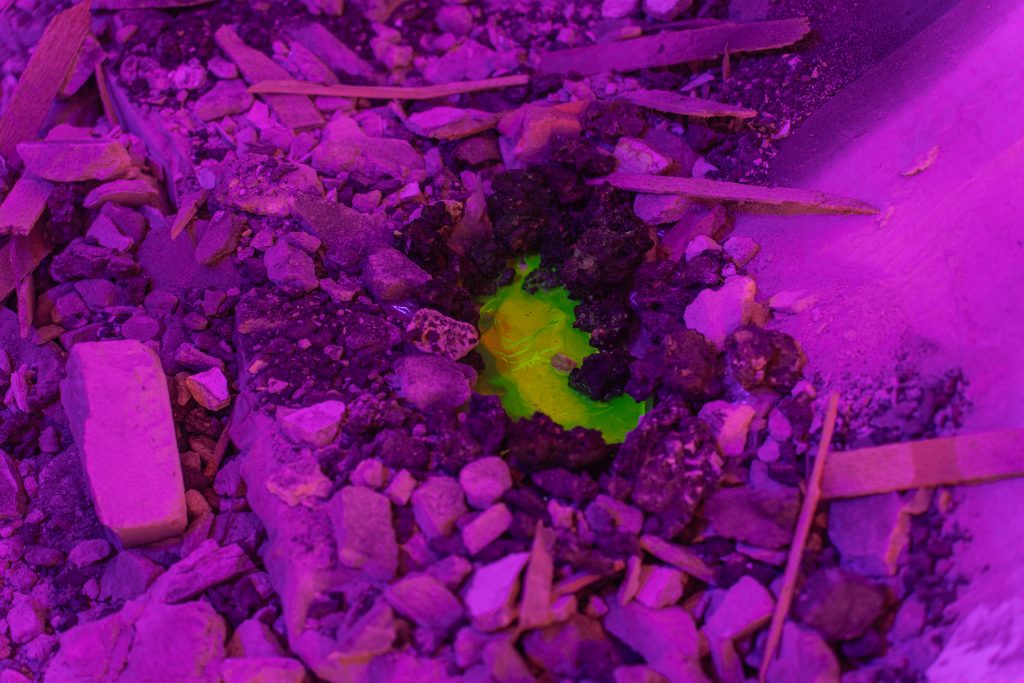
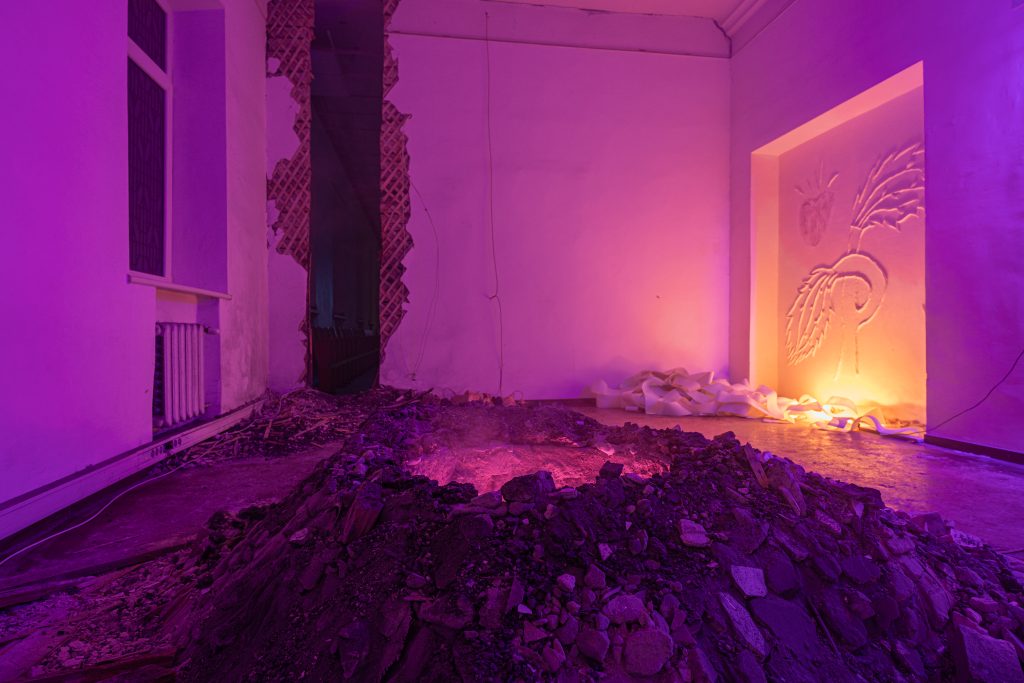
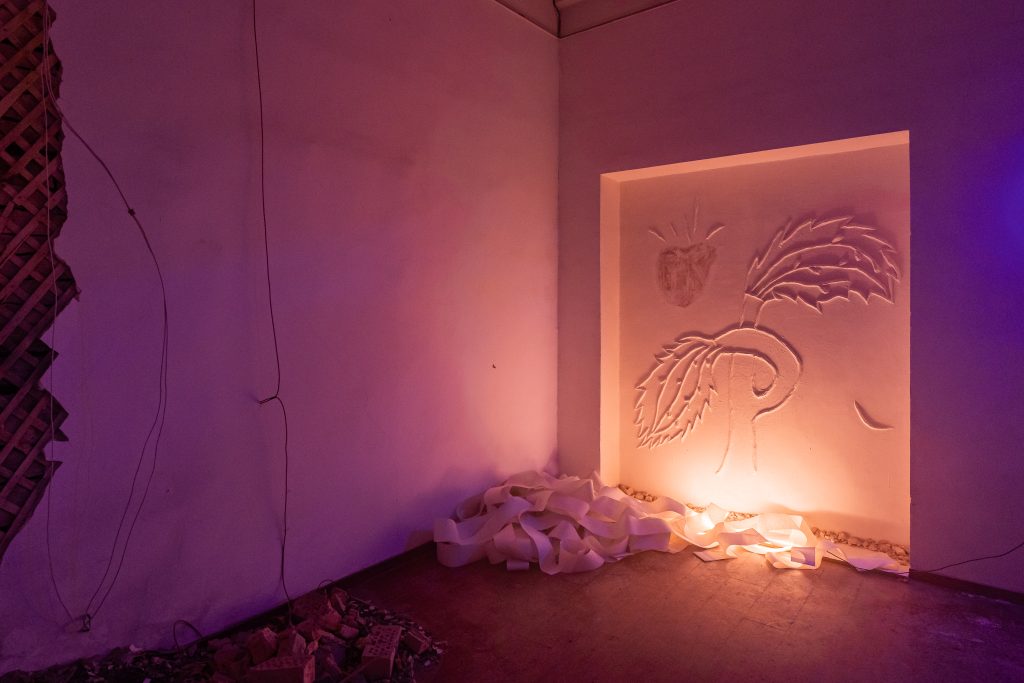
Guest artist: Justas Bø. Lightcatcher
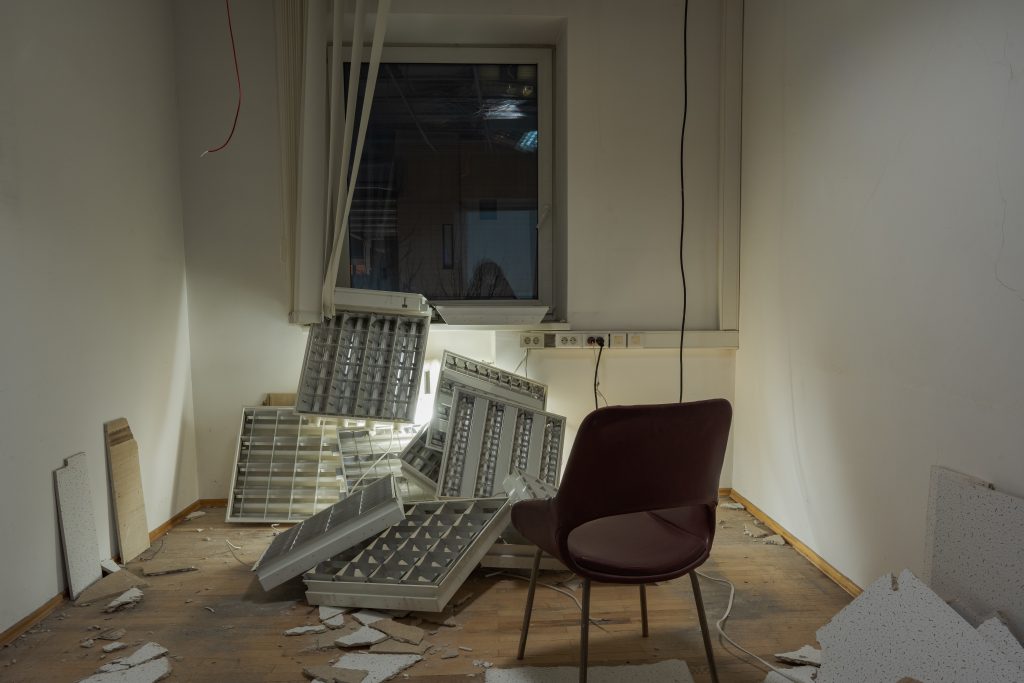
Guest artist: Laīna (Kerolaina Linkeviča). nether
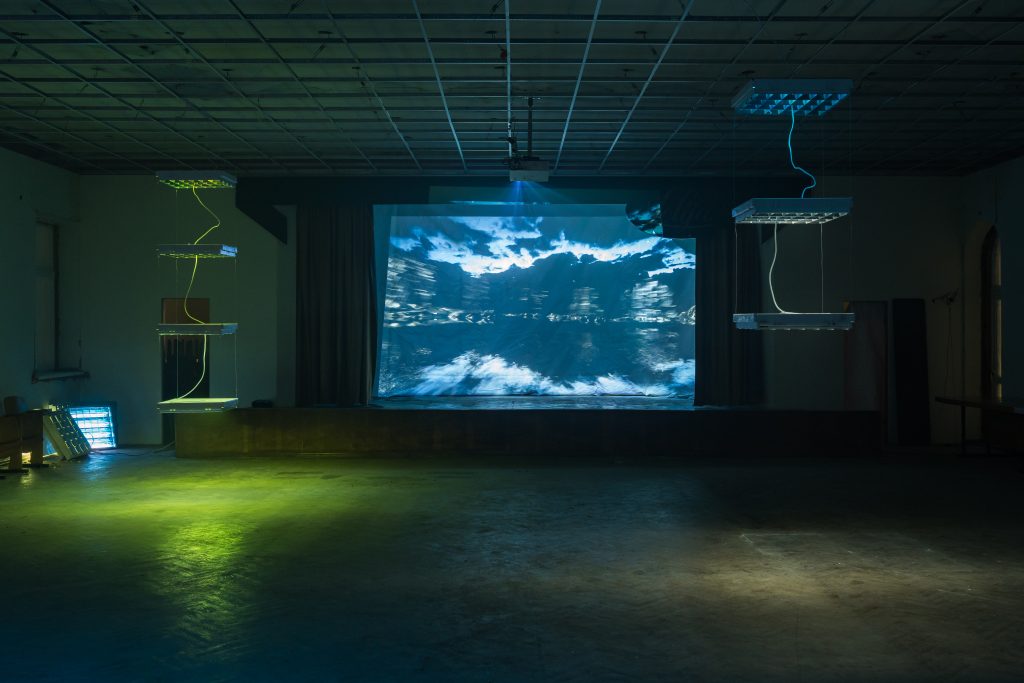

Group Healing Reading Group
Text written by Rokas Vaičiulis
Despite writing this conclusive text by the end of the AEP, I struggle to conclude the plot of the reading group: I think that the plot itself was to gather in the vicinities of Vilnius convenient for the GHRG’s regulars, which for the most part was Steph Joyce, Will Krauland and me. Started in this year’s mid summer, on Tuesdays – first at 4 pm, later at 6 pm – we discussed texts and bid farewells to the setting evening sun, first outdoors by our shared studio at Lelija, later indoors at the BREW cafe by the MO museum (with the exceptions being the one walk-and-talk between me and Steph in October, and the one reading session by Will, Steph and Églantine streamed live on Radio Vilnius in November).
GHRG or Group Help Reading Group was the title for the AEP’s informal reading group proposed by Steph. In my opinion, the very name is the hint towards the arrangement of the group and its workings: it is the group-ness that comes first, later the help and the reading. The group-ness of the group prefigured the gatherings as both directed at helping to carry through each reading, as well as an attempt to proceed reading as a means for group therapeutic aim or simply to get to know each other in an extracurricular setting.
The themes of the readings did not follow from a single unifying scheme but rather sprung from the node of different interests, engagements and initiatives – a cluster of promises, to use a phrase by Lauren Berlant. Though, in retrospect, the readings turned out to commonly revolve around the issues such as shared affects, social and cohabitative interdependencies, as well as the frameworks that would address such collective configurations and – possibly – sustain the practices that challenge the oppressive knowledge-power relations that condition them: be it the undercommons, cruel optimism, tender pessimism, object relations theories or reparative readings. As such, each reading presupposed itself as founded upon a situation, the practical matters of concern: ranging from the questions on the micro-dynamics and the art practices of the AEP group to the discussion of the broader actualities of institutionalised norms and inequalities and the like.
The relevance of the readings is by no means limited to the context of AEP itself. Anyone searching for reading suggestions and caring perspectives is encouraged to explore the reading list and view it as an incentive to observe and sustain interdependencies for their own context – and to raise the questions together, through reading, while gathered in situations.
Besides us three regulars, our group was joined by other lovely readers, the great majority of them being the AEP participants, too: Églantine Laprie-Sentenac, Eglė Ruibytė, Ella Jo Skinner, Kamilė Krasauskaitė, Lux Sauer, Evelyn Wh-ell and Theresa Zwerschke.
Bibliography
- Lugones, María. “Moving through the Text.” In Pilgrimages/Peregrinajes: Theorizing Coalition Against Multiple Oppressions, 54–60. Lanham: Rowman & Littlefield, 2003.
- Lugones, María. “Structure/Anti-structure and Agency Under Oppression.” In Pilgrimages/Peregrinajes: Theorizing Coalition Against Multiple Oppressions, 82–94. Lanham: Rowman & Littlefield, 2003.
- Freeman, Jo. “The Tyranny of Structurelessness.” Women’s Studies Quarterly 41, no. 3–4 (2013): 231–46. https://doi.org/10.1353/wsq.2013.0072.
- Harney, Stefano, and Fred Moten. “Politics Surrounded”. In The Undercommons: Fugitive Planning & Black Study, 14–21. Wivenhoe: Minor Compositions, 2013.
- Harney, Stephano, and Fred Moten. “The University and the Undercommons.” In: The Undercommons: Fugitive Planning & Black Study, 22–43. Wivenhoe: Minor Compositions, 2013.
- Berlant, Lauren. “Cruel Optimism.” differences 17, no. 3 (2006): 20–36. https://doi.org/10.1215/10407391-2006-009.
- Ashtor, Gila. “Tender Pessimism.” differences 33, no. 2–3 (2022): 242–61. https://doi.org/10.1215/10407391-10124788.
- Sedgwick, Eve Kosofsky. “Paranoid Reading and Reparative Reading, Or, You’re So Paranoid, You Probably Think This Essay Is About You.” In Touching Feeling: Affect, Pedagogy, Performativity, 123–51. Durham & London: Duke University Press, 2006.
- Benjamin, Jessica. “Recognition and Destruction: An Outline of Intersubjectivity.” In Like Subjects, Love Objects: Essays on Recognition and Sexual Difference, 27–48. New Haven & London: Yale University Press, 1995.
- Han, Byung-Chul. “Melancholia.” In The Agony of Eros, trans. by Erik Butler, 1–8. Cambridge, MA: MIT Press, 2017.
- Shotwell, Alexis. “Shimmering Presence: Frog, Toad, and Toxic Interdependencies.” In Against Purity: Living Ethically in Compromised Times, 77–106. Minneapolis: University of Minnesota Press, 2021.
- Robertson, Lisa. “Garments / Etruscans.” In Liz Magor: The Blue One Comes in Black, by Liz Magor et al., 57–64. Marseilles: Triangle France, 2015.
- Dodds, Susan. “Dependence, Care, and Vulnerability.” In Vulnerability: New Essays in Ethics and Feminist Philosophy, edited by Catriona Mackenzie, Wendy Rogers, and Susan Dodds, 181–203. New York: Oxford University Press, 2014.